Unser Freund Géza Frank hat sich im Mai 2021 aufgemacht, den gesamten österreichischen Limesverlauf - von Grenze zu Grenze - in Kleidung und Ausrüstung eines römischen Soldaten des 4. Jahrhunderts entlang zu marschieren.
In erster Linie sollte der Fußmarsch stattfinden in Gedenken an Prof. Hannsjörg Ubl, einen prominenten österreichischen Archäologen, der am 19.4.2021 verstorben ist. Prof. Ubl war ein Freund von Gézas Familie. Nebenbei soll die Aktion natürlich den Fokus der Medien auf den Donau-Limes lenken, dessen Ernennung zum UNESCO-Weltkulturerbe ansteht. Nicht zuletzt geht es auch um experimentelle Archäologie, nämlich um die Erprobung der rekonstruierten Ausrüstung unter Marschbedingungen.
Wir beschliessen, Géza auf der zweiten Hälfte seines Marsches mit Pferd und Wagen zu begleiten.
Gute Gelegenheit, unsere neue provinzialrömische Darstellung zum ersten Mal auszuprobieren.
Unsere erste Etappe startet in Mautern an der Donau, am Pfingstmontag dem 24. Mai 2021.
Nach ausgiebigen Telefonaten finden wir eine Möglichkeit, am Vorabend mit Rufus in Rossatz in der Wachau zu übernachten.
Wir fahren am Pfingstsonntag im Morgengrauen in Ammerfeld los, hinten im Pferdehänger auf der einen Seite Rufus, auf der anderen Seite unser zerlegter Karren. Niemand will etwas von uns sehen an der Grenze, weder den Corona-Schnelltest noch das amtstierärztliche Attest fürs Pferd. Wir fahren einfach durch.
Als wir nach etwa 5 Stunden in Rossatz eintreffen und die Adresse suchen, können wir kaum glauben, wie eng hier teilweise die Gassen sind. Ich will Bert zum Rollfährenweg lotsen, aber er sagt: "da kommen wir nicht durch" und biegt in die andere Richtung ab. Wieder stehen wir an einer Engstelle. Zwei Männer, am Zaun in ein Gespräch vertieft, bemerken uns und fragen, wo wir hinwollen. Einer der Herren bietet an, voraus zu fahren und den Weg zu zeigen. Wir erfahren, daß Herr Schreibers Marillengarten direkt neben unserem Stall liegt. Er dirigiert uns durch das 2 Meter enge Nadelöhr und zeigt uns den kleinen Pfad zum Hof - ohne ihn hätten wir hier nie hingefunden!
Am Stall treffen wir auf zwei sehr nette Einsteller, die uns alles zeigen. Wir fühlen uns willkommen und stellen fest, daß die Wachauer äußerst freundliche Menschen sind. Abends kommt der Besitzer, der 85-jährige Eberhard Hubmayer, mit seiner Lebensgefährtin Maria vorbei und wir verbringen einen vergnügten Abend miteinander. Dem alten Herrn Hubmayer strahlt der Schalk aus den Augen, daß es eine Freude ist!
Wir schlafen in der kleinen Sattelkammer - es ist alles recht eng und ganz einfach, aber alle sind extrem herzlich.
24.5.2021:
Wir stehen zeitig auf und traben munter mit unserem Wägelchen die 5 km von Rossatz nach Mautern. Bert sitzt auf dem Kutschbock, ich mache es mir hinten im Karren bequem und halte unsere einjährige Hütehündin Frieda an der Leine. Die alte Maja muß diesmal zu Hause bei meiner Mutter bleiben - für einen zwölfjährigen Hund ist die Reise vermutlich zu anstrengend.
Unser Treffpunkt ist das Museum in Mautern, das Kastell Favianis.
Hier steht ein Pressetermin mit zwei Fotografen an. Herzlichen Dank an Gabriele Moser und Martin Kalchhauser für die Erlaubnis, die Bilder hier kostenfrei einzustellen.
.JPG) |
.JPG) |
Für diesen einen Marschtag werden wir von den "Ursi Aurei" begleitet, einer jungen Gruppe aus St. Pölten, die Legionäre aus dem 1. Jahrhundert darstellen.
_Kopie.jpg) |
Neben Leona, Lukas und den anderen zwei Legionären stößt noch Andrea Höller zu uns, mit der wir online befreundet sind, die wir nun aber zum ersten Mal persönlich treffen.
Wir sind noch nicht weit aus Mautern herausmarschiert, da werden wir schon zu einer Pause eingeladen, und zwar von der Fotografin Gabriele Moser. Sie hat bei sich zu Hause ein großes Buffet aufgefahren, etliche Freunde sind da, um sich mit uns zu unterhalten. Familie Saahs vom Weingut Nikolaihof spendiert nicht nur den delikaten Wein vor Ort, sondern gibt uns noch zwei Weinkartons mit auf die Reise, als Wegzehrung.
Wir wandern durch die Wachau. Gelegentliche Regenschauer können uns die Laune nicht verderben. Die Hügel fordern aber ihr Tribut und wir sind ganz schön geschafft. Nach einem langen Anstieg rasten wir zu Füßen des Klosters Göttweig. Im Ort Krustetten am Göttweiger Berg werden wir aufs Herzlichste zum Weingut Müller eingeladen, wo wir noch eine Pause einlegen und uns auch kurz mit Freunden von Géza und Andrea treffen, die uns sozusagen "aufgelauert" hatten. Auch Familie Müller versorgt uns für den weiteren Weg mit ausgiebigen Weinvorräten. Langsam wird das ein Alkoholtransport...
Angekommen in Traismauer, verabschieden sich unsere Mitwanderer.
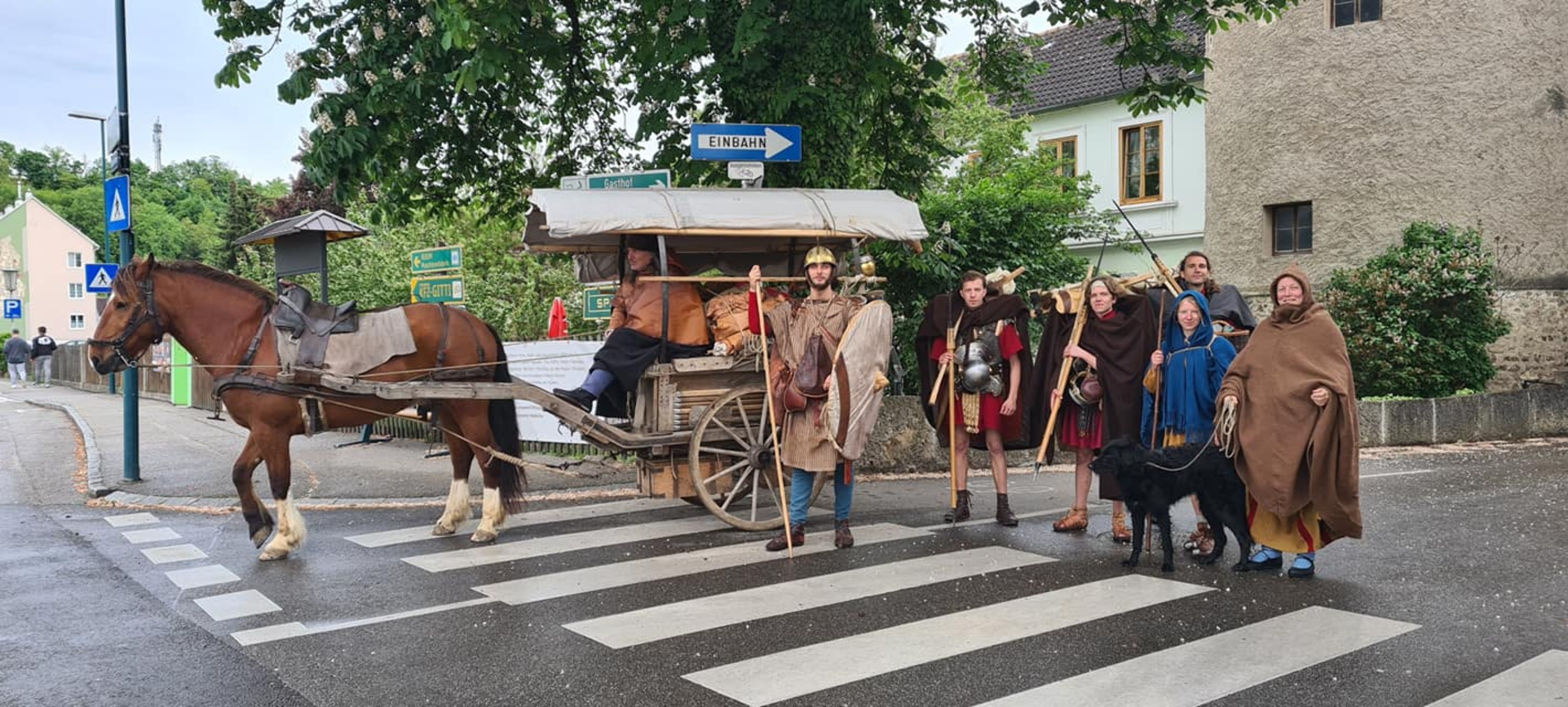
Géza und wir müssen allerdings noch ein paar Kilometer bewältigen bis zu unserem Nachtquartier im Schweizerhof.

Die Vegetation ist sehr üppig und am Ende versperrt uns noch eine Schranke beinahe den Weg (FILM 4:00). Zum Glück können wir den gehorsamen Rufus Schritt für Schritt drum herum führen.
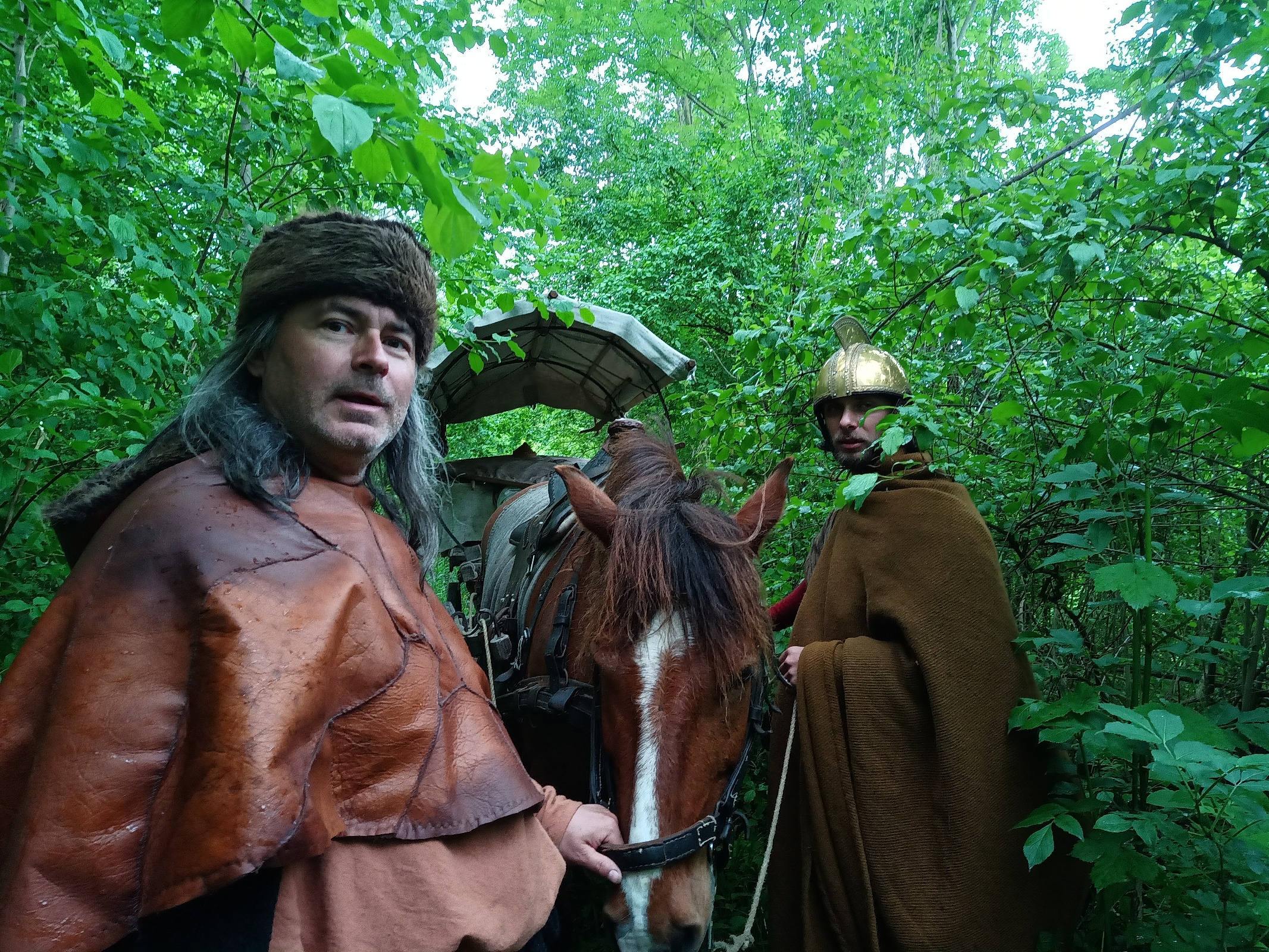
Der Schweizerhof wurde vor über 100 Jahren am Standort einer Villa Rustica gebaut. Das Gehöft gehörte einst der Familie Rothschild und wurde nach 1945 von der Familie Dressler erworben, die den Hof auch heute noch betreibt.
Die Pferdeanlage ist dreigeteilt: der mittlere Bereich ist für Freizeitreiter reserviert, an einer Seite logiert ein Profireiter, auf der anderen Seite betreiben André Stockinger und Laura Kuczwara einen Korrekturstall für Problempferde.
Dr. Gustav Dressler engagiert sich mit viel Herzblut für die ökologische Landwirtschaft. Überall auf dem riesigen Anwesen werden seltene Baumarten angepflanzt.
Als wir dort eintreffen, steht uns der Sinn aber erst mal nach Ruhe. Die Etappe war extrem anstengend.
Rufus bekommt einen Paddock mit Hütte in Sichtweite zu anderen Pferden. Wir schlagen unser Lager in der großen Halle auf, die die modernen Pferdeboxen beherbergt - trotz des großzügigen Angebots von Dr. Dressler, die Nacht doch lieber im beheizten Reiterstüberl zu verbringen.
Laura Kuczwara vom NHT-Team, die auf dem Schweizerhof wohnt, bringt uns eine heiße Suppe, die ihr Freund zubereitet hat. Er sei Koch, erklärt sie.
Wir probieren das "Süppchen" und sind total geflasht! Es ist eine fein gewürzte kräftige japanische Fischsuppe, und sie ist ratzeputz verzehrt bis aufs letzte Tröpfchen. Am nächsten Morgen verrät uns Herr Dressler, daß Lauras Freund ein Haubenkoch ist und im japanischen Nobelrestaurant "Shiki" in Wien angestellt ist. Gut, daß wir das erst nachher erfahren haben, sonst hätten wir uns nicht getraut, das leckere Süppchen so gierig reinzulöffeln!
Sorgen macht uns allerdings Gézas Fuß, der eindeutig überlastet ist, angeschwollen und sehr schmerzhaft.
25.5.2021:
Herr Dressler verwöhnt uns am nächsten Morgen mit frischen Gebäck, Eiern und Lachs. Es ist uns richtig peinlich, daß er sich solch eine Mühe für uns macht und nicht mal einen Obulus für unsere und Rufus' Übernachtung annehmen will. An dieser Stelle noch einmal herzlichen Dank für die Herzlichkeit und Großzügigkeit!
Gézas Fuß schaut nicht gut aus. Er ist dick geschwollen und Géza kann kaum gehen, geschweige denn marschieren. Wir vermuten, daß es sich vielleicht sogar um einen Überlastungsbruch handelt.
Unser Karren wird so gepackt, daß auch Géza noch hinten Platz nehmen kann. Bequem ist das sicher nicht, aber laufen ist wirklich unmöglich. Géza ist froh, daß er seinen Marsch nicht komplett abbrechen muß.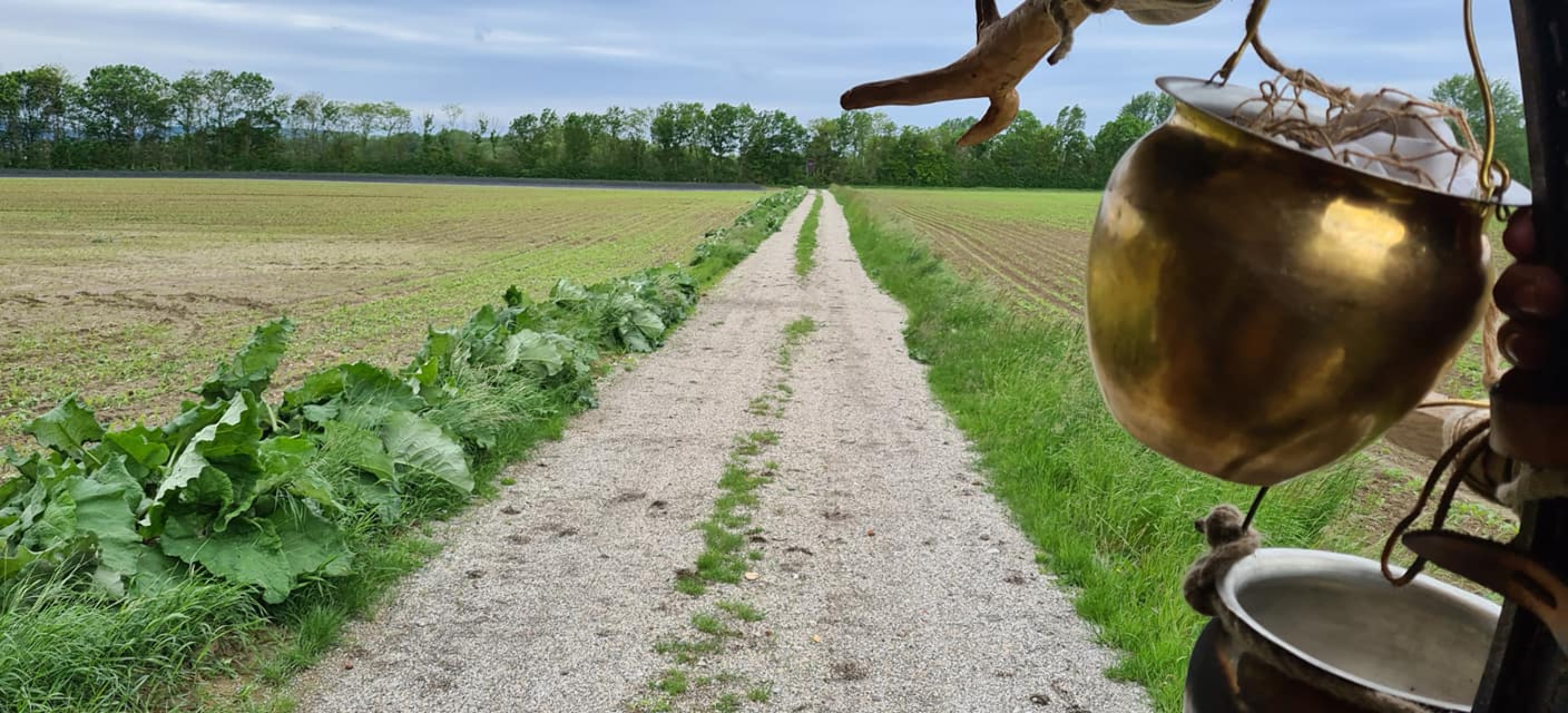
Zu dritt auf dem Karren haben wir den Vorteil, daß wir Rufus traben lassen können und so ordentlich Strecke machen. Das Gelände ist eben und unser Pferdchen trottet zufrieden dahin, die Landschaft zieht an uns vorbei. Unglaublich, wieviel schneller man doch im Trab voran kommt.
In Zwentendorf kehren wir mittags ein bei einem Freund von Géza, dem Archäologen Klaus Michael Nedelko. Mitten im Neubaugebiet wird Rufus samt Karren an einem Laternenpfahl geparkt - wie schon in Mautern bei Gabriele Moser - und wir lassen uns von Klaus bewirten mit einem feinen Risotto und leckerem Rotwein aus Apulien.
Weiter geht's im Trab, zu dritt auf dem Karren. Frieda läuft nebenher, manchmal frei, aber meistens an der Leine wegen des Verkehrs. Das funktioniert wunderbar.
In Tulln steuern wir den Reitclub Tulln an. Die Pferde auf den Paddocks haben Angst vor dem Karren mit seinen scheppernden eisenbeschlagenen Rädern, eines der Pferde springt aus dem Stand über den Koppelzaun und muß auf dem gegenüber liegenden Sportplatz wieder eingefangen werden. Zum Glück passiert nichts weiter, wir kommen alle mit dem Schrecken davon.
Wir schirren aus, Rufus wird die Nacht hier auf einem der Paddocks verbringen.
Wir Menschen gehen zu Fuß Richtung Zentrum von Tulln.
Hier, an dieser idyllischen Stelle, sollte eigentlich die Werft für die neu zu bauende römische Lusoria aus dem 4. Jahrhundert entstehen:
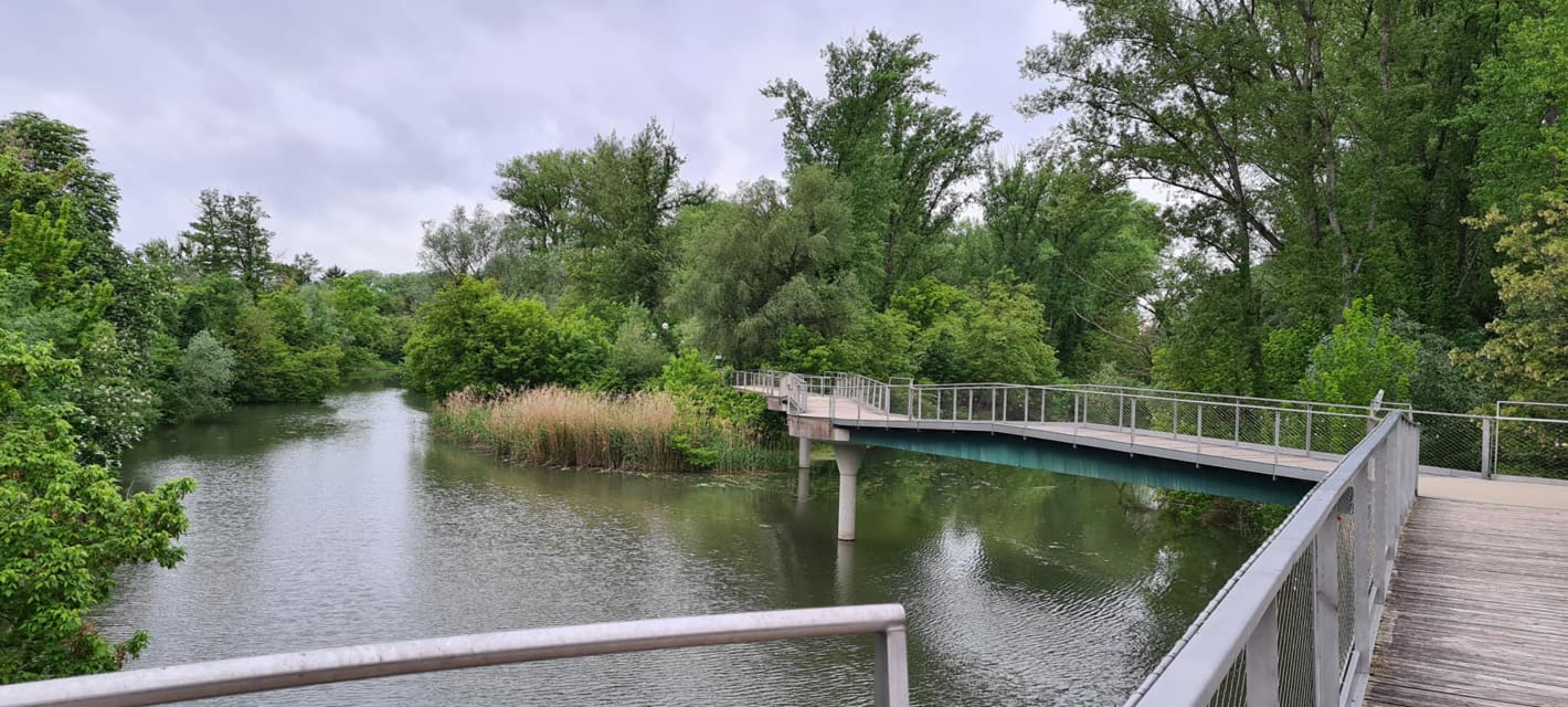
Dann wurde das Projekt aber an die Uni Erlangen vergeben und die "Danuvina Alacris" wird jetzt in Schlungenhof am Altmühlsee gebaut.
Bert und ich sind für diese Nacht bei Gézas Eltern Monika und Horst-Dieter Frank in Hadersfeld eingeladen.
Sie machen sich ziemliche Sorgen um den lädierten Fuß ihres Sohnes...
Gézas Eltern sind entzückende Leute. Wir werden mitsamt unserem Hund so herzlich willkommen geheissen, daß wir gar nicht in Worten ausdrücken können, wie wohl wir uns dort gefühlt haben. Als wären wir Teil der Familie. Nach einem großartigen Abendessen fallen wir müde ins bequeme Bett im Gästezimmer.
26.5.2021:
Am nächsten Morgen sieht Gézas Fuß nicht wirklich besser aus. Trotzdem ist er wild entschlossen, den Marsch fortzusetzen. Allerdings geht das auch heute nur auf dem Karren.
Eigentlich wollten wir die nächste Nacht in Hadersfeld verbringen, das liegt aber oben auf dem Hügel. Steile Serpentinen führen kilometerweit hinauf. Das wäre zu viel für Rufus mit 3 Leuten an Bord, da könnte er mit Müh und Not den unbemannten Wagen hochschleppen - und auch das wäre schon fraglich wegen des vielen Gepäcks. Wir müssen also umdisponieren. Statt die Abkürzung über den Höhenzug zu nehmen, werden wir der weiten Donauschleife außen herum folgen. Diese alternative Strecke ist zwar etliche Kilometer länger, führt aber ständig durch ebenes Gelände.
Zunächst aber fährt uns Gézas Vater zurück zum Reitclub Tulln, wo wir Rufus wieder anschirren und uns anschließend zum Pressetermin am Stadtmuseum Tulln begeben.
Wir besichtigen das Museum mit seinen römischen Exponaten und posieren für ein paar Fotos.
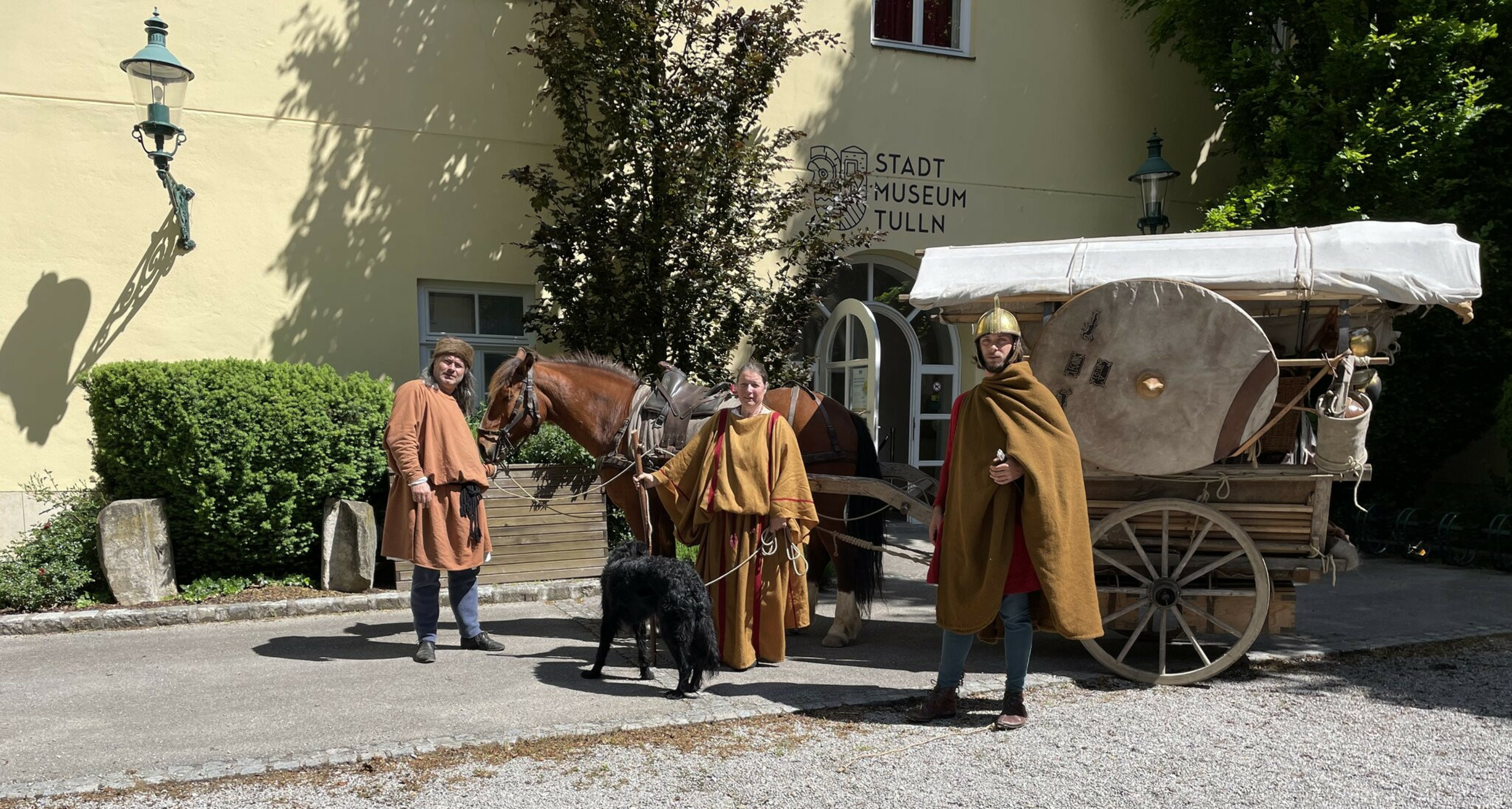
Hier treffen wir auch Christiane Stift wieder, die Vorsitzende des Reitvereins Tulln. Wie wir jetzt erfahren, war ihr Mann jahrelang der Bürgermeister von Tulln und unter seiner Amtsherrschaft wurde auch das Marc Aurel Denkmal errichtet. Selbstverständlich finden wir uns auch dort auf der Donaupromenade zu einem Fototermin ein.
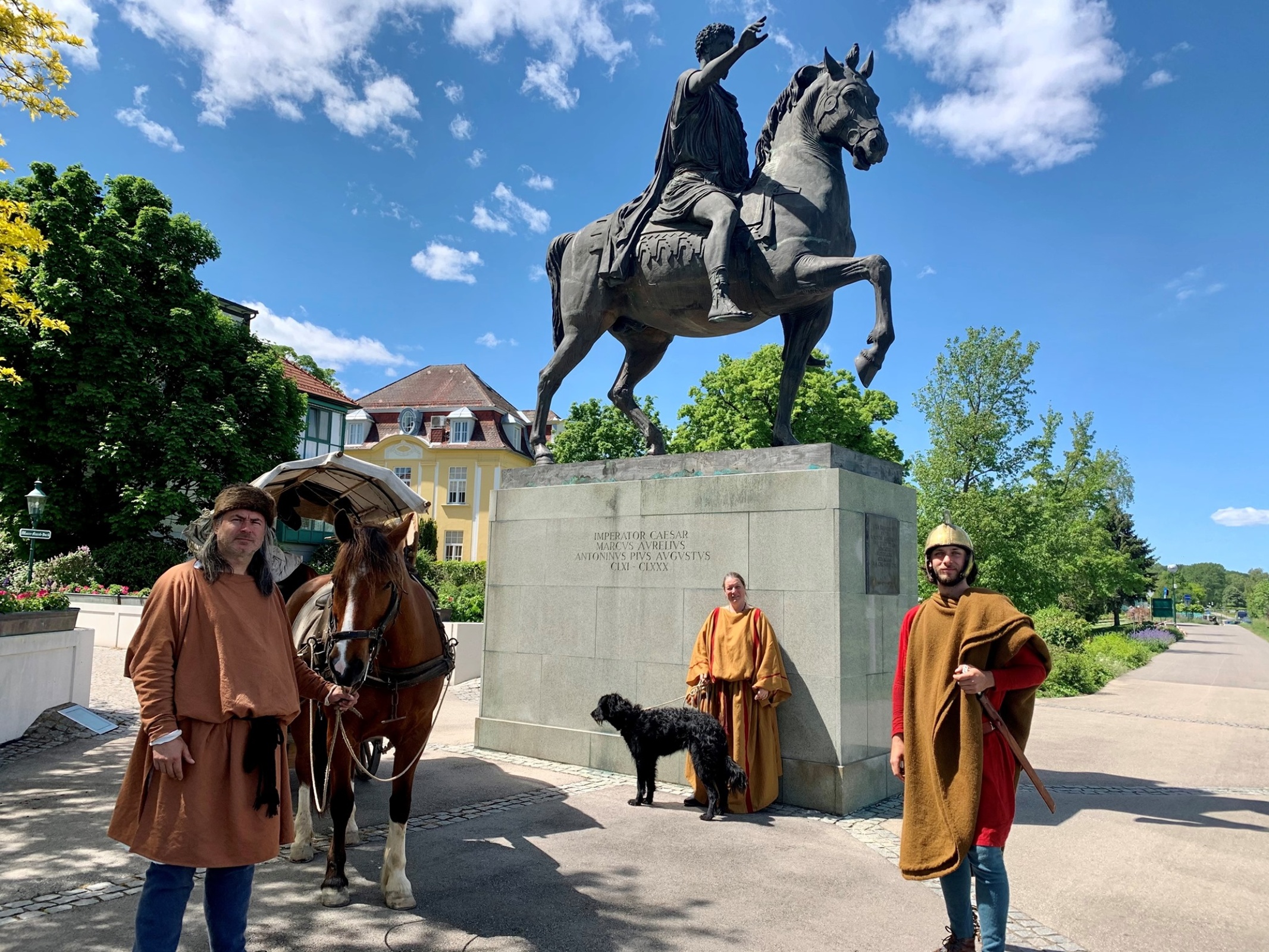
Von Tulln aus folgen wir dem Donau-Radwanderweg, zu dritt auf dem Karren, Frieda an der Leine hinter- bzw. nebenher. Im Trab kommen wir wieder zügig voran.
Zu Mittag halten wir in Zeiselmauer, etwas abseits von der Donau. Dort sind noch beeindruckende Reste des römischen Auxiliarkastells zu sehen.
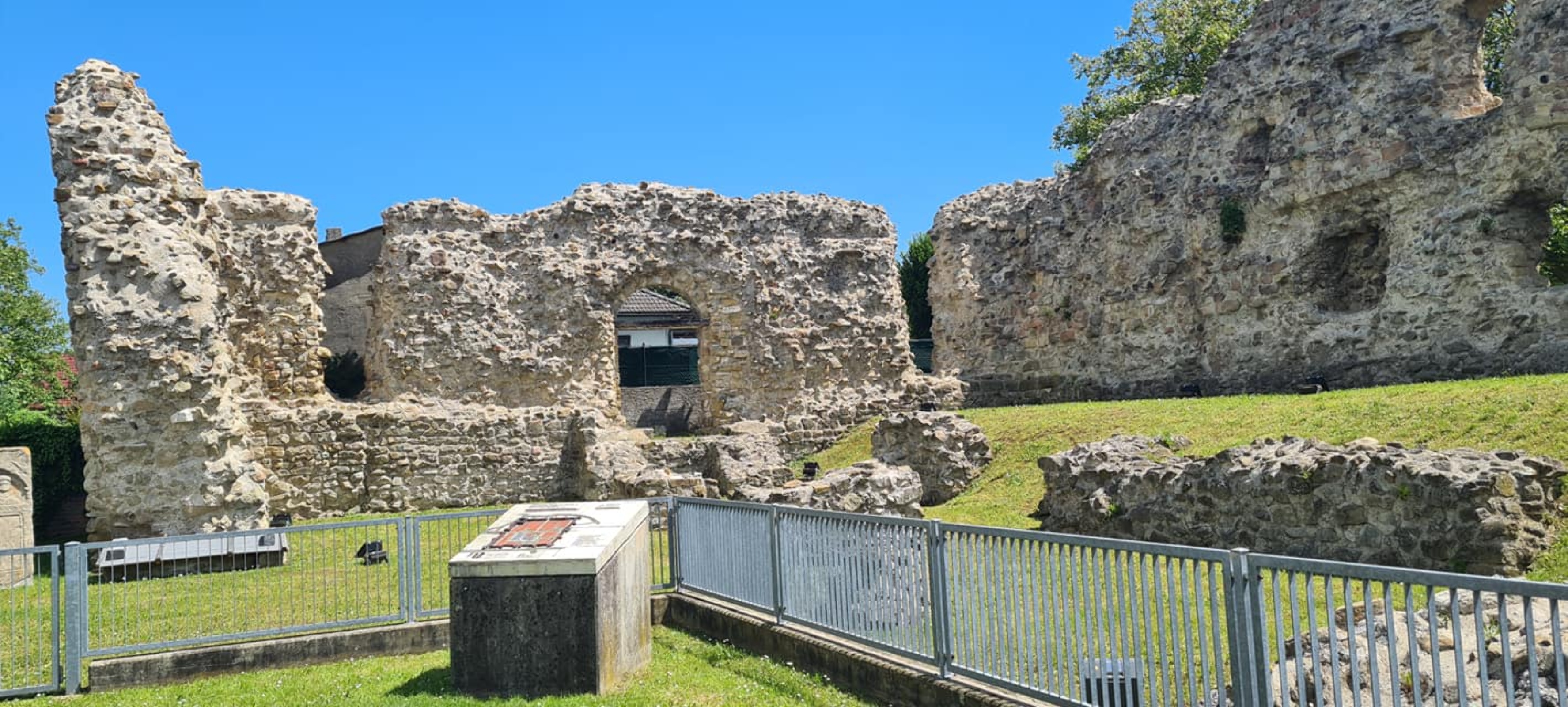
Nach einer erholsamen Verschnaufpause begeben wir uns zurück an den Fluß. Unterhalb der Burgruine Greifenstein treffen wir wieder auf unseren alten Bekannten, den "Treppelweg". Einst Treidelpfad, heute hauptsächlich Bestandteil des Donau-Radwanderwegs.
Das Gebiet ist hier dicht besiedelt.
In Höflein an der Donau machen zwei Hunde hinterm Zaun ein Mords-Spektakel. Frieda will zu ihnen hinrennen, ich hole sie an der Leine zurück. Frieda läuft aber nicht zu mir hinter den Wagen, sondern seitlich in den Karren hinein. Wir hören nur ein schrilles Kreischen und dann Friedas Jaulen... sie ist mit dem Fuß unter das eisenbereifte Rad gekommen!
Wir stehen erst einmal da wie vom Donner gerührt. Ist der Fuß überhaupt noch dran? Ja, ist er. Aber gebrochen? Überall ist Blut...
Wir greifen zum Telefon - nur gut, daß wir so rasch Hilfe herbeiholen können.
Gézas Vater kommt mit dem Auto und bringt mich mit Frieda zum Tierarzt nach Klosterneuburg. Dr. Andreas Schnabl ist ein recht eigenwilliger Tierarzt, er ist ziemlich strack und geradeheraus und Gézas Vater muß ihm gleich assistieren. Frieda wird in Narkose gelegt, die tiefe Schnittwunde im Ballen muß gesäubert und mit etlichen Stichen genäht werden. An der Oberfläche der Pfote haben wir nur eine Schürfwunde und die Zehen scheinen nicht gebrochen zu sein: drei Mittelhandknochen kann Dr. Schnabl befühlen und sie sind noch ganz, beim vierten ist er sich nicht sicher.
In einer Wolldecke aus dem Auto schleppen Gézas Vater und ich (mit meiner flatternden Tunica bekleidet) den schlafenden Hund gute 100 Meter durchs Zentrum von Klosterneuburg. Der ganzen Situation haftet etwas zutiefst Surreales an.
Mir ist alles wurscht - Hauptsache, Frieda wird wieder.
Bert und Géza sind unterdessen mit Rufus weitergezogen. Sie suchen einen geeigneten Platz für ein Lager bei Klosterneuburg, da wir ja eigentlich woanders übernachten wollten. Géza kennt sich hier zum Glück gut aus, denn er wohnt ja ganz in der Nähe. Durch einen schmalen zugewucherten Trampelpfad, der vom Treppelweg in den Wald abzweigt, kommt man zu einem offenen Platz im Augebiet bei Kritzendorf. Dort können wir die Nacht verbringen, stören niemanden und werden auch nicht gestört. (FILM 2:11)
Nach längerem Suchen findet Gézas Vater die angegebene Stelle, die mit dem Auto nicht ohne weiteres zu erreichen ist.
Géza fährt mit seinem Vater nach Hause, weil er noch ein paar Dinge für die Übernachtung braucht. Als er zurückkommt, hat seine Mutter groß für uns aufgekocht: es gibt Schnitzel und Kartoffelsalat und für die arme Frieda Hühnchen mit Reis.
Ich will mich noch einmal ganz herzlich bei Monika und Hans-Dieter bedanken - es ist mir eine Ehre, euch kennen gelernt zu haben!
27.5.2021:
Frieda muß jetzt auf dem Wagen fahren, was ihr überhaupt nicht behagt. Dauernd versucht sie, herunter zu springen. Bert muß sie mit zwei Stricken regelrecht festzurren, was sie mit anklagendem Gewinsel quittiert. Wir sitzen weiterhin zu dritt auf dem Karren, zockeln jetzt aber nur noch im Schritt voran. Macht nichts, die heutige Strecke ist nicht so weit.
Wir folgen weiterhin dem Radweg, kommen an der Rollfähre vorbei und halten dort ein Schwätzchen mit drei interessierten Herren, die gerade in ihre Autos steigen wollen, als wir vorüberziehen. Selbige Herren treffen wir bald wieder: ich sehe im Vorbeifahren im Industriegebiet von Klosterneuburg - hinten im Wagen sitzend - wild winkende Gestalten vor einer Bierhütte, die uns zur Umkehr bewegen wollen...
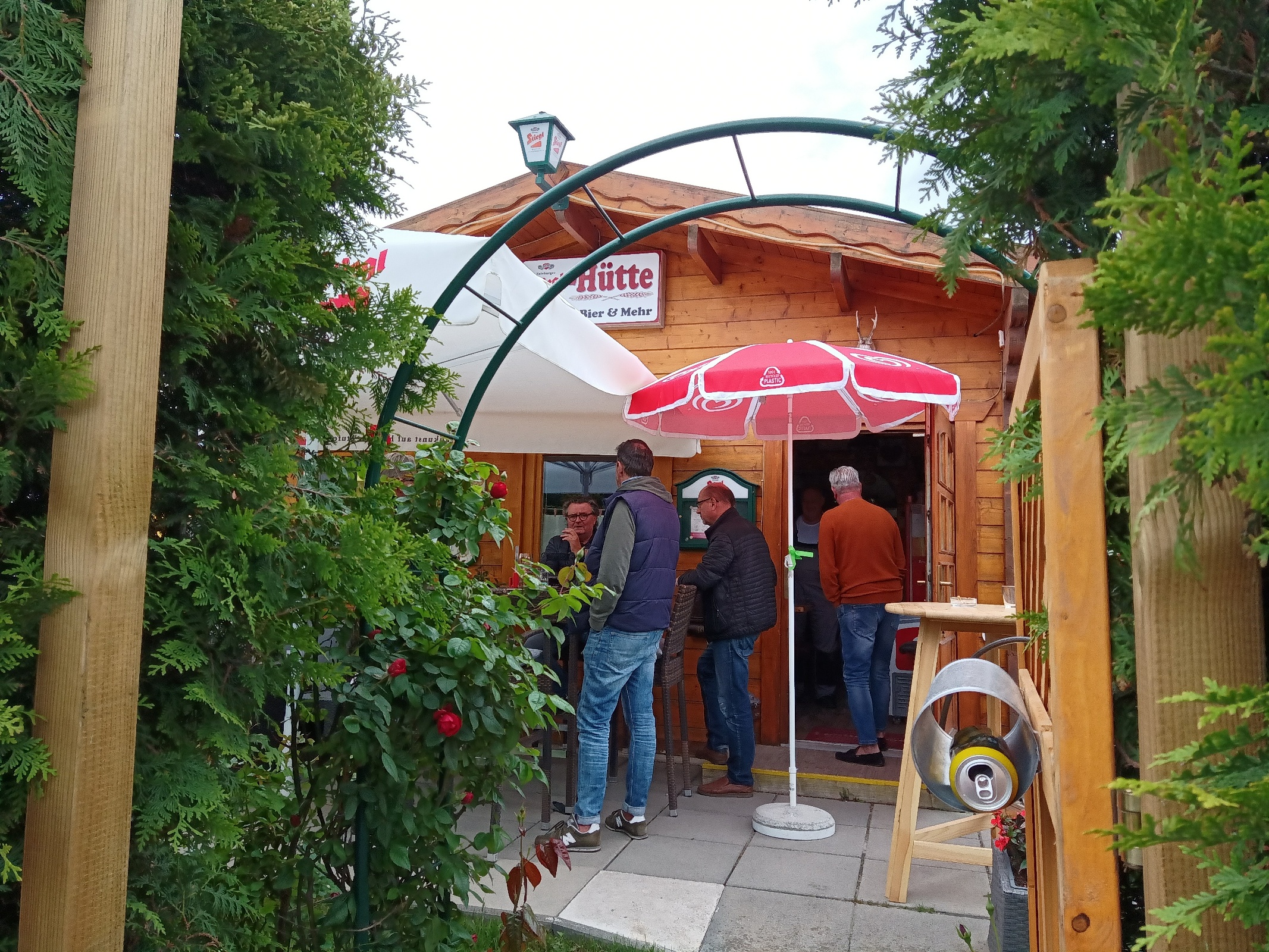 |
 |
An der Imbisshütte von Agnieszka Steinbauer gibt es Bier für uns und Rufus, unsere Freunde von der Rollfähre spendieren uns sogar noch Würstl mit Senf und Kren. Speziell der Wagen weckt ihr Interesse und wir haben Mühe, uns von der netten und interessierten Unterhaltung zu lösen.
Aber wir müssen ja weiter... Immer am Fluß entlang beginnen wir mit der Durchquerung von Wien (FILM 1:03).
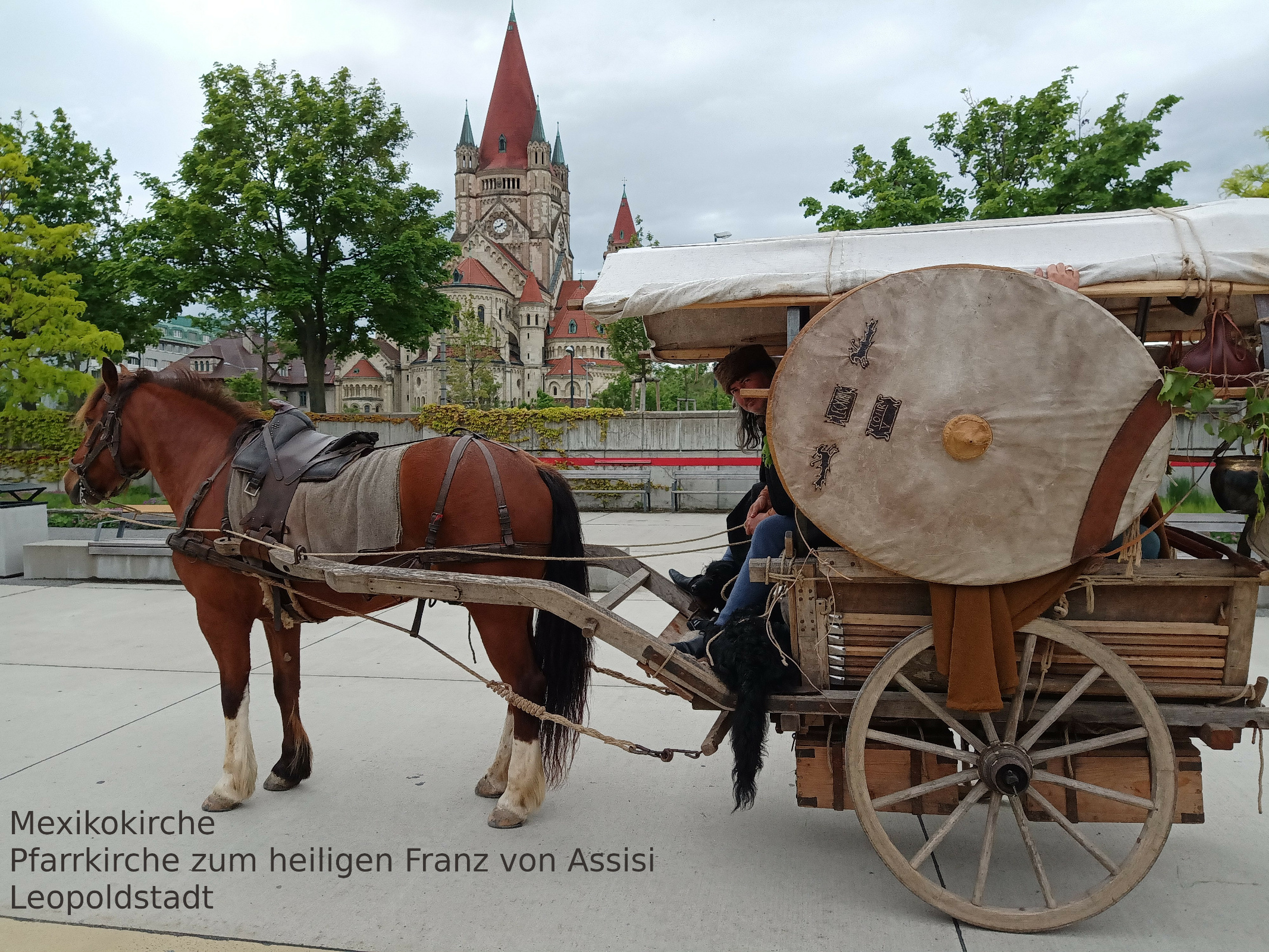
Der Weg an der Donau entlang führt uns durch den Hafen. Wehende Fahnen, schlafende Polizisten (ich meine die Hindernisse am Boden), Springbrunnen, auf dem Wasser dümpelnde festgetäute Schiffe - ganz schön viele neue Eindrücke für Rufus. Anfangs steige ich noch ab und gehe zu Fuß neben ihm her, aber unser Pferd macht brav seinen Job und ich kann bald wieder hinten aufsitzen.
Dann gruselt sich Rufus aber doch vor dem unbekannten Geräusch von schwappenden Wellen an einem Schiff. Er kann das Geräusch nicht einordnen und beschließt, lieber umzudrehen. Das macht er ganz ruhig und geordnet: 90 Grad zur Seite gehen, Wagen vorsichtig zurückschieben und in die Richtung zurückgehen, aus der er gekommen ist. Dummerweise schafft er es bei dieser Aktion, rückwärts zwischen zwei Pollern einzuparken. Ein Rad bleibt an einem der Betonpoller hängen und wird beschädigt - die Speichen sind locker und das Rad eiert...
Gézas Fuß kaputt, Friedas Fuß kaputt, ein Wagenrad angeschlagen...
Übernachten dürfen wir im Heeresreitsportverein Wien am Prater. Wir hatten von Zuhause aus schon Kontakt hergestellt zu Daniel Stachl vom HRSV, denn gerade die Übernachtung mitten in Wien schien uns eines der größten Probleme unserer Tour zu sein.
Einen besseren Ort hätten wir nicht finden können! Trotz recht beengter Verhältnisse herrscht hier eine sehr freundliche und lockere Athmosphäre. Und das, obwohl wir eigentlich heute ziemlich ungelegen kommen, da einige Reitschüler ihre Prüfung zur Reiternadel ablegen.
Herzlichen Glückwunsch noch mal an die jungen Damen!
Aus jedem Eck schaut hier ein Pferd - vom Shetty bis zum Super-Turnierpferd - und alle sind ruhig und gelassen, keiner flippt aus wegen unserem Schepperkarren. Es gibt eine Hand voll frei laufender Hunde und total coole schwarze Hühner.
Es wäre ein Paradies - wenn es nur die Möglichkeit für Koppeln gäbe...
Géza reitet Rufus ohne Sattel in der Reithalle und fällt tatsächlich zum ersten Mal in seinem Leben vom Pferd. Rufus ist halt verdammt rund und glatt...
Daniel grillt am Abend für uns und er unterhält sich angeregt mit Géza, von (Berufs-) Offizier zu (Miliz-) Offizier. Beide plaudern ein wenig aus dem Nähkästchen. Schlafen dürfen wir auf den Sofas im Stüberl.

v.l.n.r.: Julia Dunker (Reitlehrerin), Taifun (Shetty und Maskottchen), Daniel Stachl (Springreiter), Albert Schwark (Fuhrmann), Rufus (Freiberger, Karrengaul), Géza Frank (Limitaneus), Henrike Schwark (Römerin aus Vindelica) und Frieda (Altdeutscher Hütehund)
28.5.2021:
Wir verabschieden uns von den Leuten des HRSV (FILM 1:17). Diesmal geht es nicht hinunter in den Prater (das wäre ein schmaler steiler Pfad bergab - nicht so toll für unseren hoch beladenen Wagen), sondern vorne zum Tor heraus auf die "Hafenzufahrtsstraße".
Géza möchte eigentlich wieder laufen. Wir bewegen uns aber im Industriegebiet durch dichten Verkehr. Also sitzt er auf, damit wir traben können und den Verkehr nicht über Gebühr behindern. Zahlreiche LKWs überholen uns, die Fahrer winken freundlich und zücken ihre Handys für ein Foto. Viele Fahrer kommen vermutlich aus Osteuropa und freuen sich sichtlich über unser unkonventionelles Fahrzeug. Nicht ein einziger ist dabei, der genervt wirkt, weil wir ihn aufhalten. (FILM 0:20)
Allerdings bemerken wir, daß unser Rad größeren Schaden genommen hat als wir dachten. Das Rad eiert bei jeder Umdrehung, die Speichen drücken sich in die Nabe und werden wieder herausgezogen, je nach Radstand.
Kaum raus aus dem Verkehr, steigen wir alle ab und laufen, um das Rad zu schonen. Nur Frieda muß - sehr zu ihrem Leidwesen - weiterhin fahren, "gefesselt" auf dem Fußbrett vor dem Kutschbock.
Der Weg durch den Auwald hält einige Überraschungen für uns bereit.
Über das Wildgitter kommen wir ja noch gut rüber. Auf der Höhe des Flughafens Schwechat, gleich hinter der Kläranlage, blockiert uns dann aber eine Schranke den Weg. Wir sind diesen Weg schon kilometerweit gekommen. Umdrehen und nach einer Alternative suchen ist völlig ausgeschlossen. Man fragt sich schon, was sich manche Behörden bei so etwas denken. Es gibt auch noch andere Verkehrsteilnehmer als nur Auto, Radfahrer und Fußgänger. Mal abgesehen davon, daß kein Sani-Fahrzeug da durch kommt, wenn im Auwald einer liegen bleibt und es vielleicht schnell gehen muß.
Die Schranke ist mit einem massiven Vorhängeschloß gesichert. Ich laufe zur Kläranlage und frage nach dem Schlüssel, aber die Mitarbeiter sind unwillig zu helfen (möglicherweise haben sie den Schlüssel auch nicht). Bert sucht unterdessen sein Werkzeug heraus, um die Schranke abzubauen - denn wie so oft ist sie nicht nur ohne Hirn aufgestellt worden, sondern auch noch ziemlich schlampig. Mit der Gripzange zieht er die Splinte aus dem Bolzen, der die Stange hält. Währenddessen fällt uns auf, daß ein Polizeihubschrauer über uns kreist. Kein Problem, der will nichts von uns, der beobachtet (hoffentlich) Flughafen oder Autobahn. Als wir die Schranke gerade abgebaut haben und uns anschicken, durchzufahren, kommt ein Auto mit Gärtnern, die auch hier durch wollen. Sie hätten den Schlüssel gehabt - schlechtes Timing... Vor ihren verdutzten Augen setzen wir die Stange mit dem Bolzen wieder ein und klopfen die Splinte fest. Fertig.
Der Weg ist zum Teil sehr idyllisch, hat aber zuweilen auch etwas Post-Apokalyptisches an sich, wenn wir unter dem Beton-Ungeheuer einer sechsspurigen Autobahn entlang wandern (FILM 0:13).
Und wieder versperrt uns eine Schranke den Weg. Diese ist zwar nicht so massiv und blockiert auch nur zwei Drittel des Weges, aber mitten im potentiellen Durchgang wurde ein Felsbrocken strategisch platziert. Da haben die Herren Wegeblockierer die Rechnung aber ohne unser Rückepferdchen gemacht. Wir schirren Rufus aus und rücken den Stein einen halben Meter beiseite, damit unser Karren durch die Lücke paßt. (FILM 7:36). Diese Aktion kostet uns mindestens eine halbe Stunde Zeit..
Ein paar Fischerhütten stehen hier am Treppelweg. Wir nutzen Tisch und Bänke für eine stärkende Mittagspause (FILM 1:40).
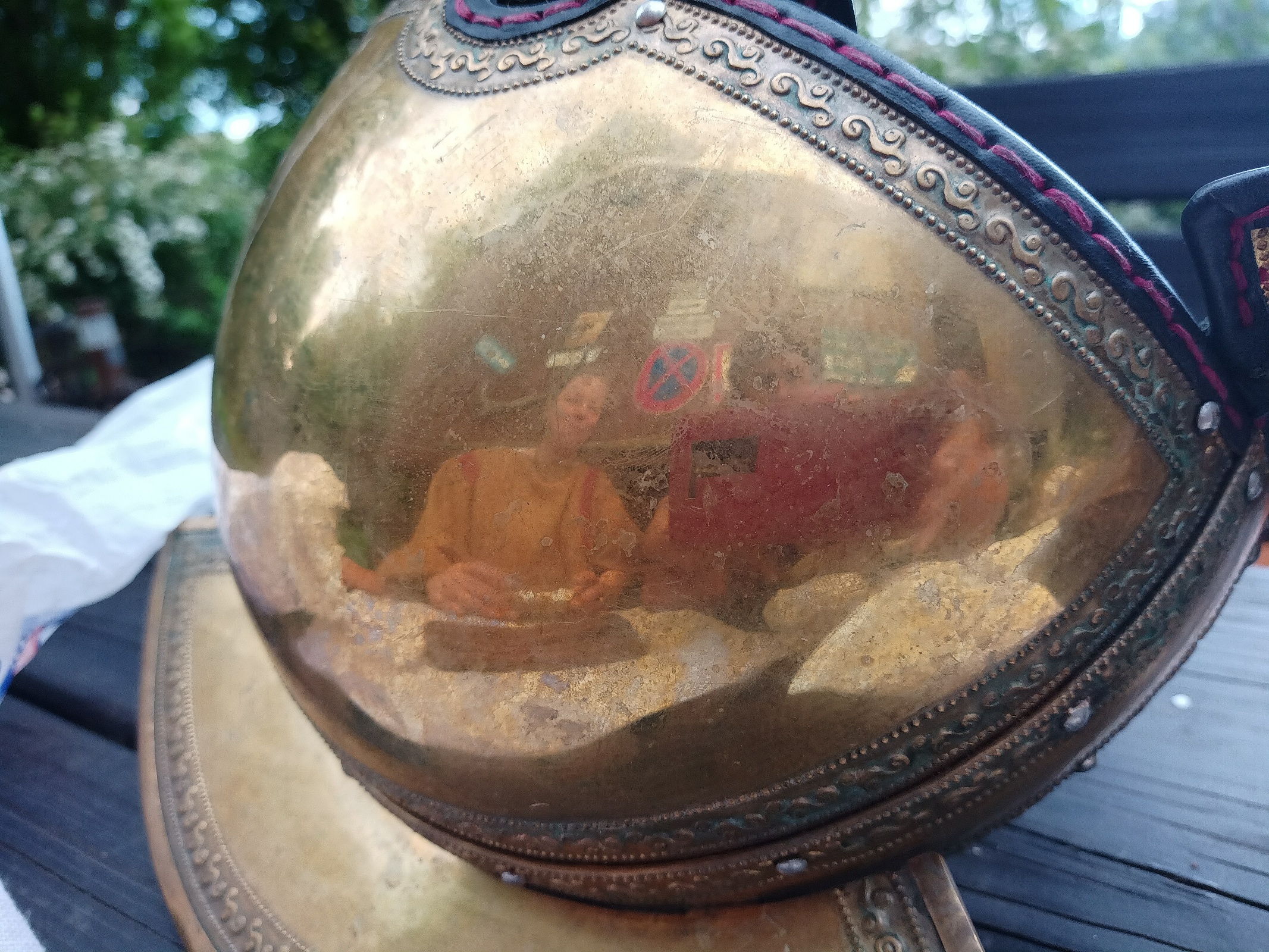 |
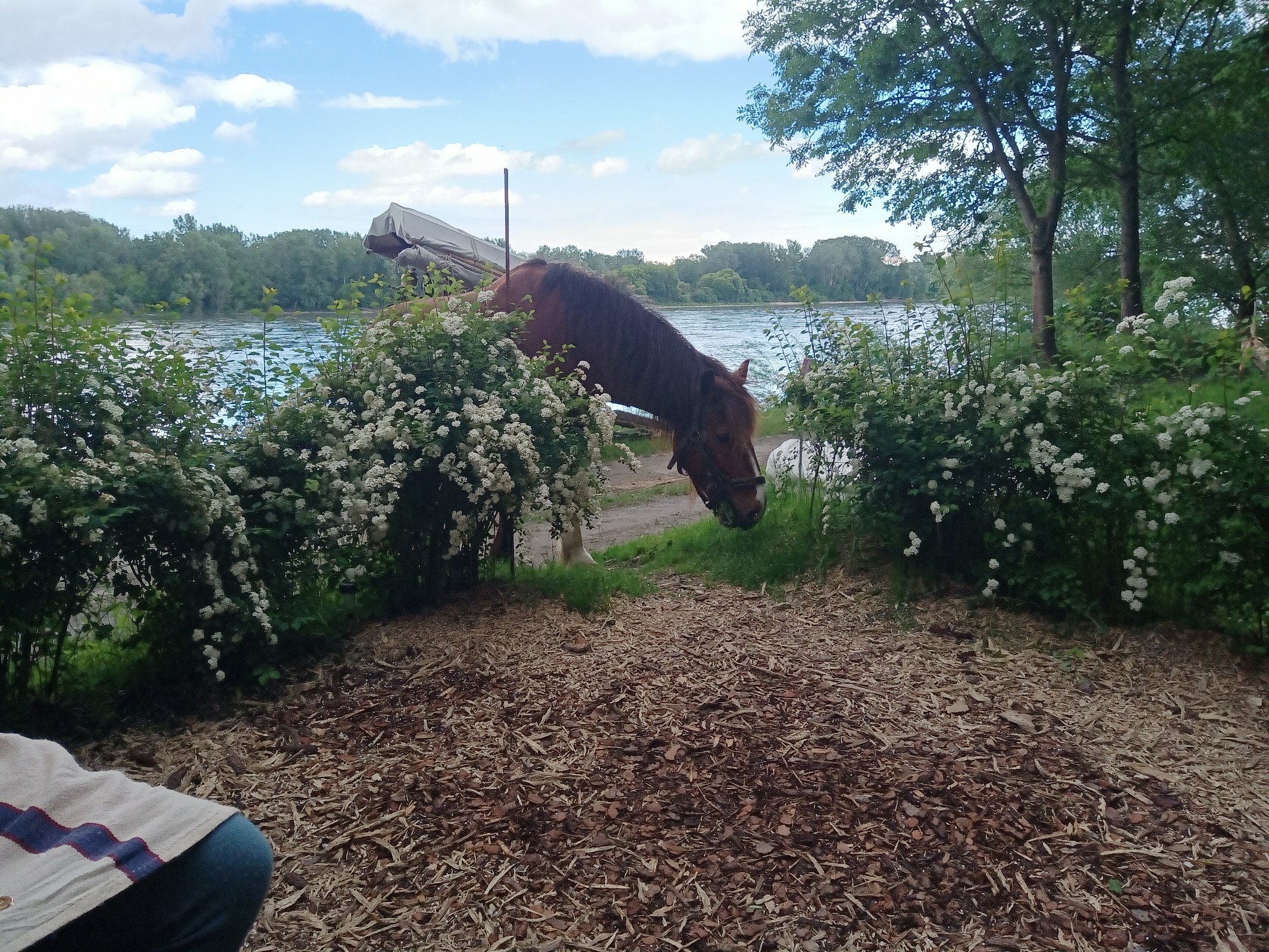 |
In Fischamend haben wir dann ein Rendezvous mit dem Tierarzt. Dr. Stephan Soukup wechselt Friedas Verband. Er stellt sie aufs Röntgengerät und tatsächlich: einer der Mittelhandknochen ist gebrochen. Das ändert aber nichts, denn das muß eh von selber wieder zusammenwachsen.
Während Frieda beim Tierarzt behandelt wird, parkt Bert das Pferd an einer Grünanlage beim Spielplatz - sofort sind alle Kinder da!
Mit frisch bandagierter Pfote muß Frieda wohl oder übel wieder auf den Karren und wir verlassen Fischamend Dorf in Richtung Auwald. Wir halten die Augen offen nach einem guten Platz für unser Lager. Wichtig ist, daß es genug Gras gibt für Rufus, denn Wasser haben wir dabei, Heu aber nicht.
Wir finden ein idyllisches Plätzchen an einem Altarm der Donau. Der Wagen steht rechts vom Weg auf einer ebenen Stelle, die sogar als Parkplatz ausgewiesen ist. Links vom Weg geht es sanft herunter zum Wasser. Hier zäunen wir mit Stricken eine Koppel ein für Rufus, und hier setzen wir uns auch am Abend gemütlich zusammen zum Essen. Die Abendstimmung ist einfach wundervoll. (FILM 0:56)
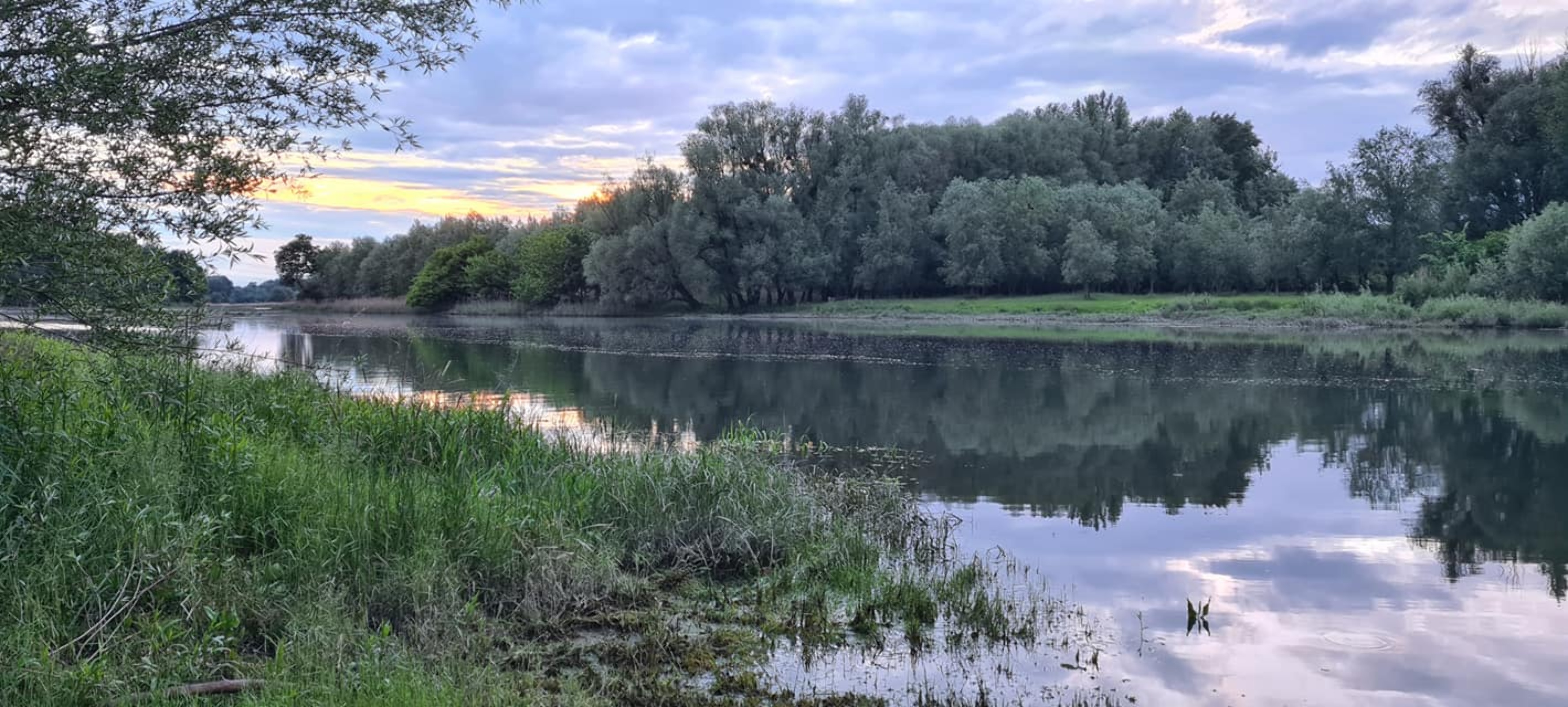
29.5.2021:
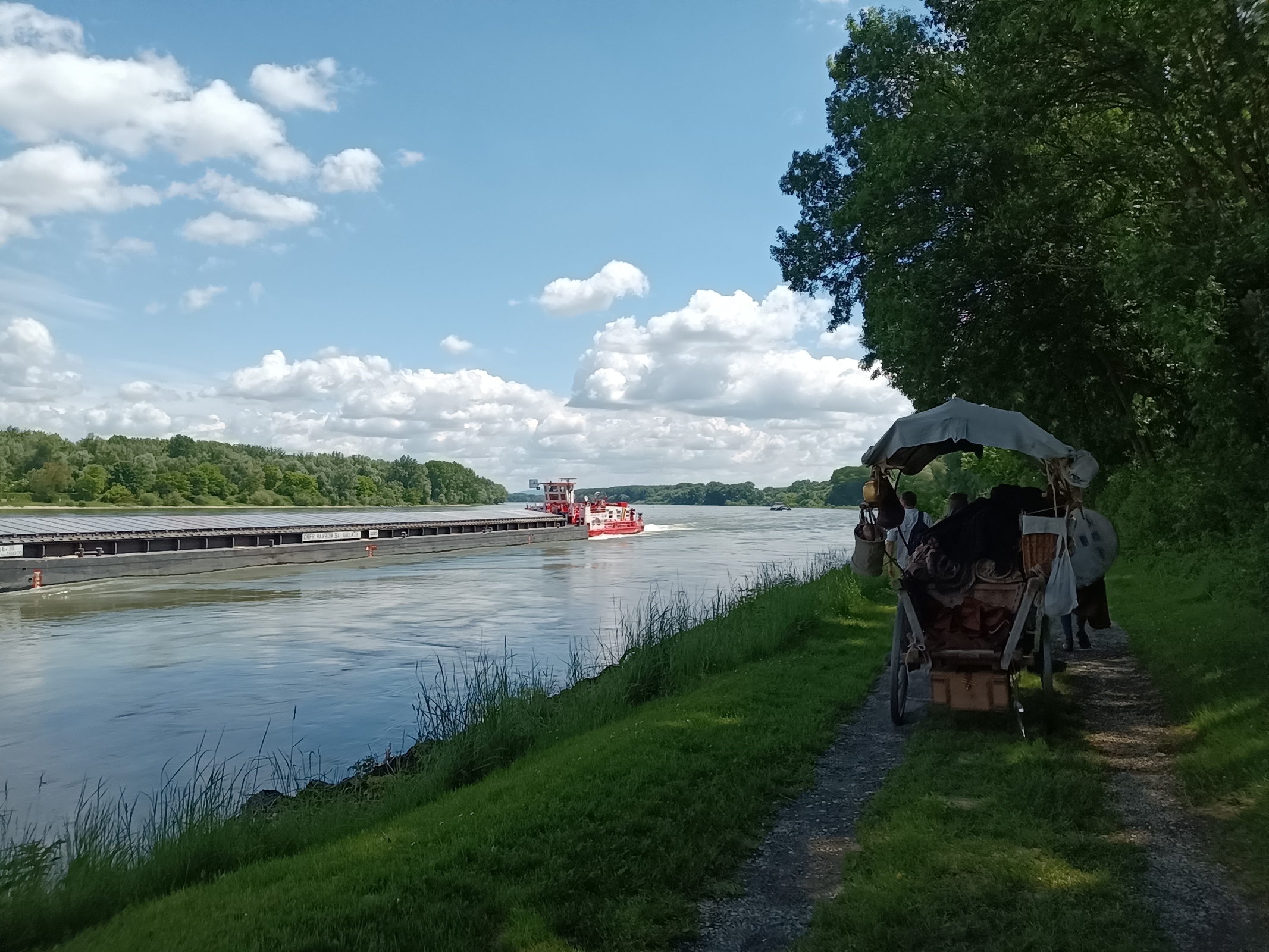 |
HIER
Der Weg führt uns durch den Nationalpark Donauauen (FILM 1:24).
Direkt an der Donau entlang bewegen wir uns auf dem alten Treidelpfad (FILM 0:59).
Hier stellen wir ein fiktives Treffen zwischen dem rätischen Fuhrmann auf dem Weg nach Carnuntum und dem fußlahmen Soldaten, der nach Pannonien abkommandiert wurde und dankbar die Mitfahrgelegenheit annimmt (FILM 2:17).
Und HIER findet ihr den kompletten Film - Vorsicht, der ist gut 40 Minuten lang!
Wir begegnen einem Ranger, der uns freundlich darauf hinweist, daß wir mit Pferd und Karren hier eigentlich nicht gehen dürfen - was insbesondere deswegen absurd ist, da wir uns hier auf dem extra so bezeichneten Treppelweg - also Treidelweg - befinden, der einmal speziell für Pferde zum Ziehen der Donaukähne angelegt worden war. Im Pflaster sieht man sogar die Gleisspuren der eisernen Karrenräder. Der Ranger, dem das alles natürlich auch bewußt ist, begleitet uns sogar ein Stück des Weges und zeigt uns auf der Karte, wo wir den Park wieder verlassen können. Eigentlich richten wir ja überhaupt keinen Schaden an, meint er. Mit einem Augenzwinkern schlägt er die "österreichische Lösung" vor: "Ich hab's euch gesagt und gehe jetzt weiter. Was ihr dann macht, ist eure Sache". Wir wollen aber tatsächlich bei Haslau weg von der Donau und hinaus auf die Felder.
Im nächsten Ort, Regelsbrunn, treffen wir den slowakischen Geschichtsdarsteller Peter Hricak, der uns bis Carnuntum begleiten wird. Seine fröhliche Art gibt uns wieder Schwung zum Weitermarschieren. Besonders für Géza ist das gut, Peter lenkt ihn von seinem schmerzenden Fuß ab. Nur ich setze mich klammheimlich hinten in den Karren, denn die neuen Schuhe haben mir Blasen beschert. Irgend einen Vorteil muß es ja haben, die Frau des Fuhrmanns zu sein...
Von Weitem sehen wir schon das Heidentor in Carnuntum, der Triumphbogen, der sozusagen das Wahrzeichen der Stadt ist. (FILM 2:07)
Rufus findet für seine letzte Nacht in Felix Austria ein exklusives Plätzchen in Gut Petronell bei Maximilian von Abensperg und Traun (FILM 2:00).
Bevor er seinen Feierabend geniessen kann, reitet Bert mit Géza aber noch zum Amphitheater. (FILM 4:09)
Ich mache in der Zwischenzeit das Museum unsicher.
Wir verbringen einen netten Abend im Apsidensaal mit Peter, der sich dann aber verabschieden muß. Géza und wir "dürfen leider nicht im Museum übernachten", wir bekommen also weder den "Roten Salon" zugeteilt noch verbringen wir dort die Nacht - und das sind nicht meine Füße, nein, nein...
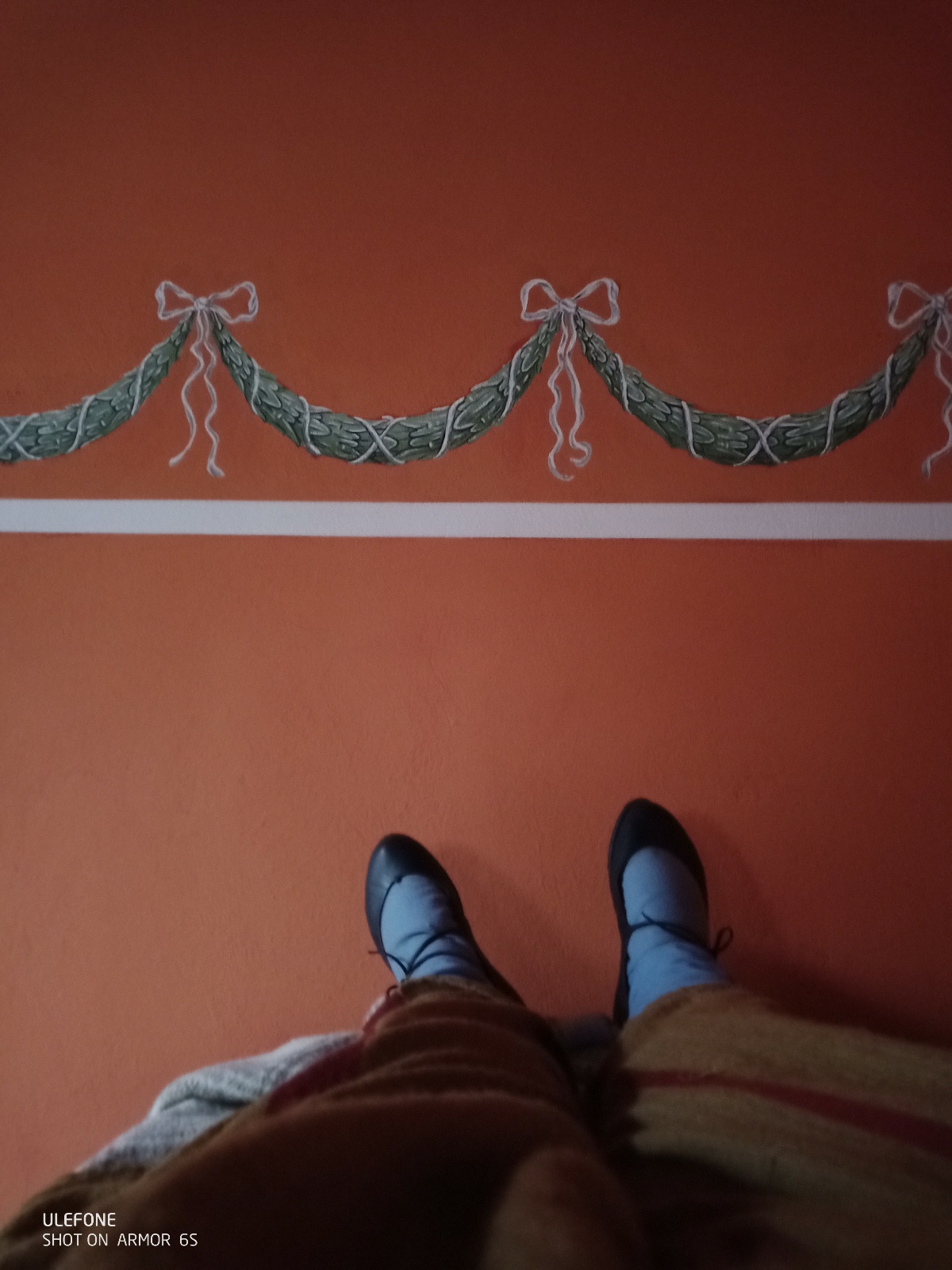
30.5.2021:
Am nächsten Morgen packen wir unsere Siebensachen zusammen, zerlegen den Wagen und bereiten uns auf den Heimweg vor. Géza läuft heute noch weiter bis zur slowakischen Grenze (begleitet ab dem Auxiliarkastell von Andrea Höller und weiteren Freunden). Trotz gebrochenem Fuß hat er es geschafft, seinen Limesmarsch erfolgreich zu Ende zu bringen.
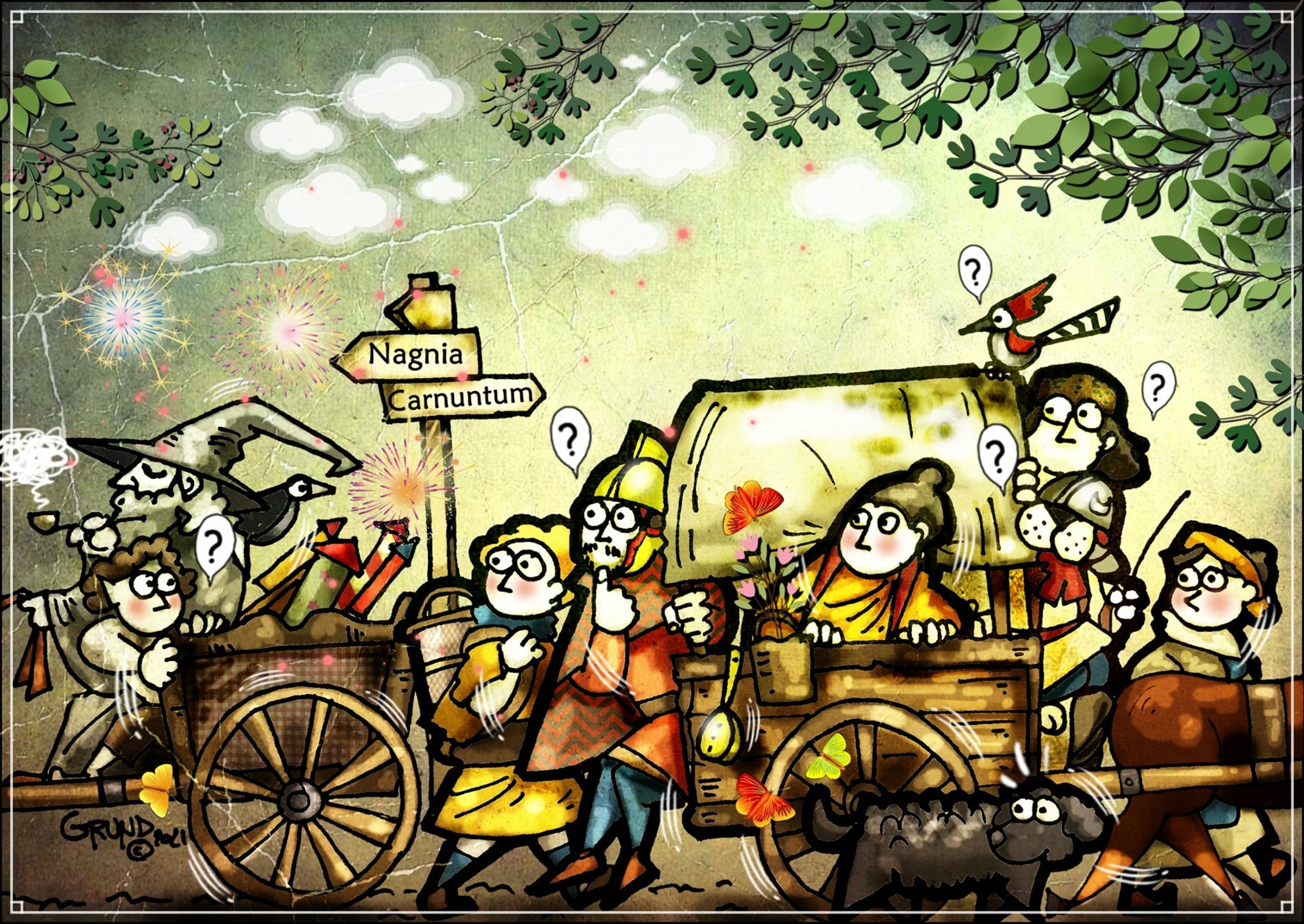
Cartoon von Fran Guil (Francisco J. Guil Grund)
in Richtung Nagnia: Gandalf und Frodo
in Richtung Carnuntum: Leona, Géza, Henrike (im Wagen), Frieda (im Vordergrund), Bert (auf dem Kutschbock), Andrea und Rufus' roter Hintern.
Wir schippern zufrieden nach Hause, gegen 21:30 Uhr sind wir wieder in Ammerfeld.
Unser Neuburger Tierarzt Dr. Schneemeier checkt am Montagmorgen Friedas Pfote. Er ist sehr zufrieden mit der Wundversorgung durch den österreichischen Kollegen.
Inzwischen ist Friedas Pfote vollständig wiederhergestellt.
Géza war inzwischen auch beim Arzt und es wurde tatsächlich ein Überlastungsbruch festgestellt.
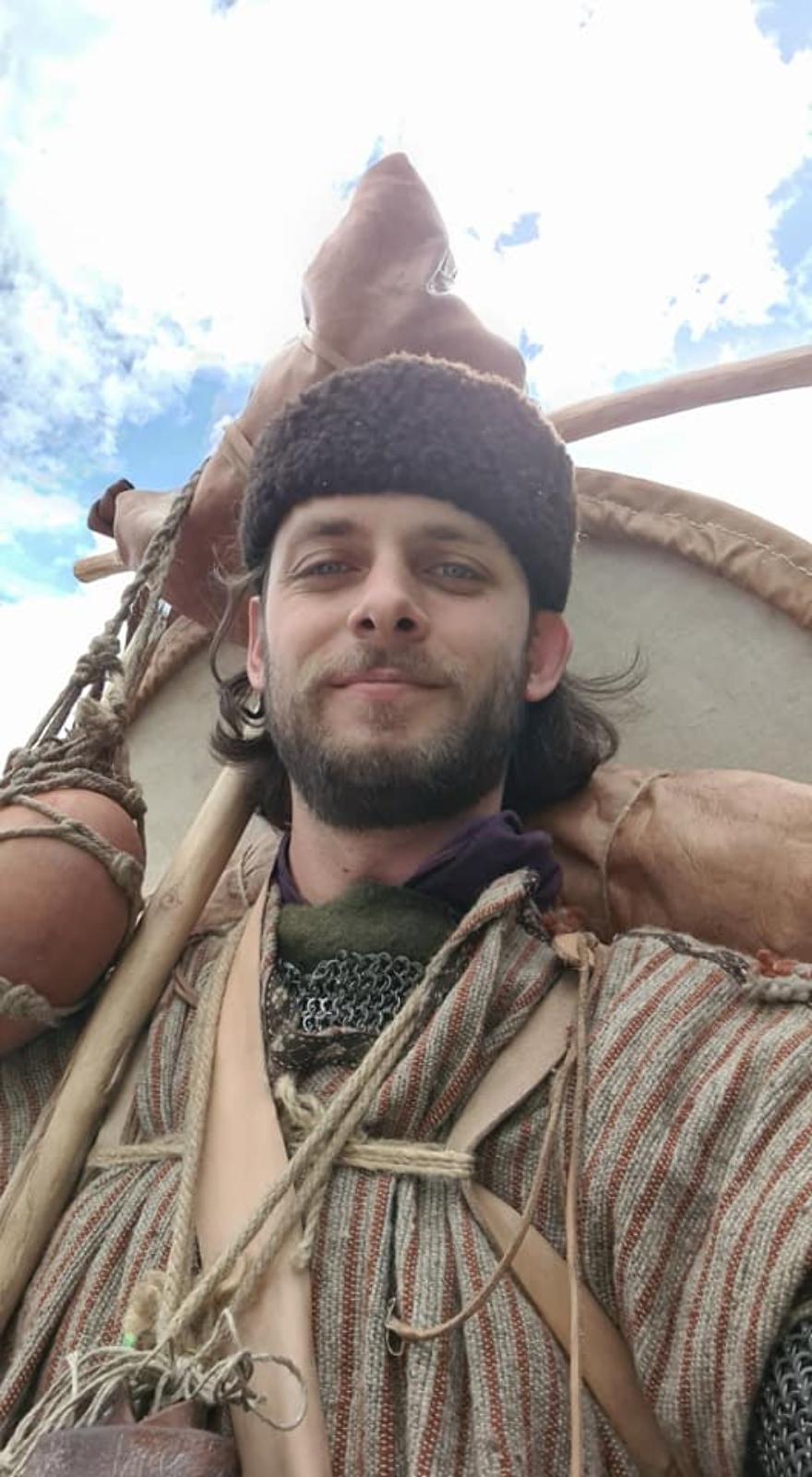 |
As announced, next week, I will set off to a commemoration march for Austrian archaeologist and friend of the family, Dr. Hannsjörg Ubl, in full kit, covering the entirety of the Austrian Danube Limes. |
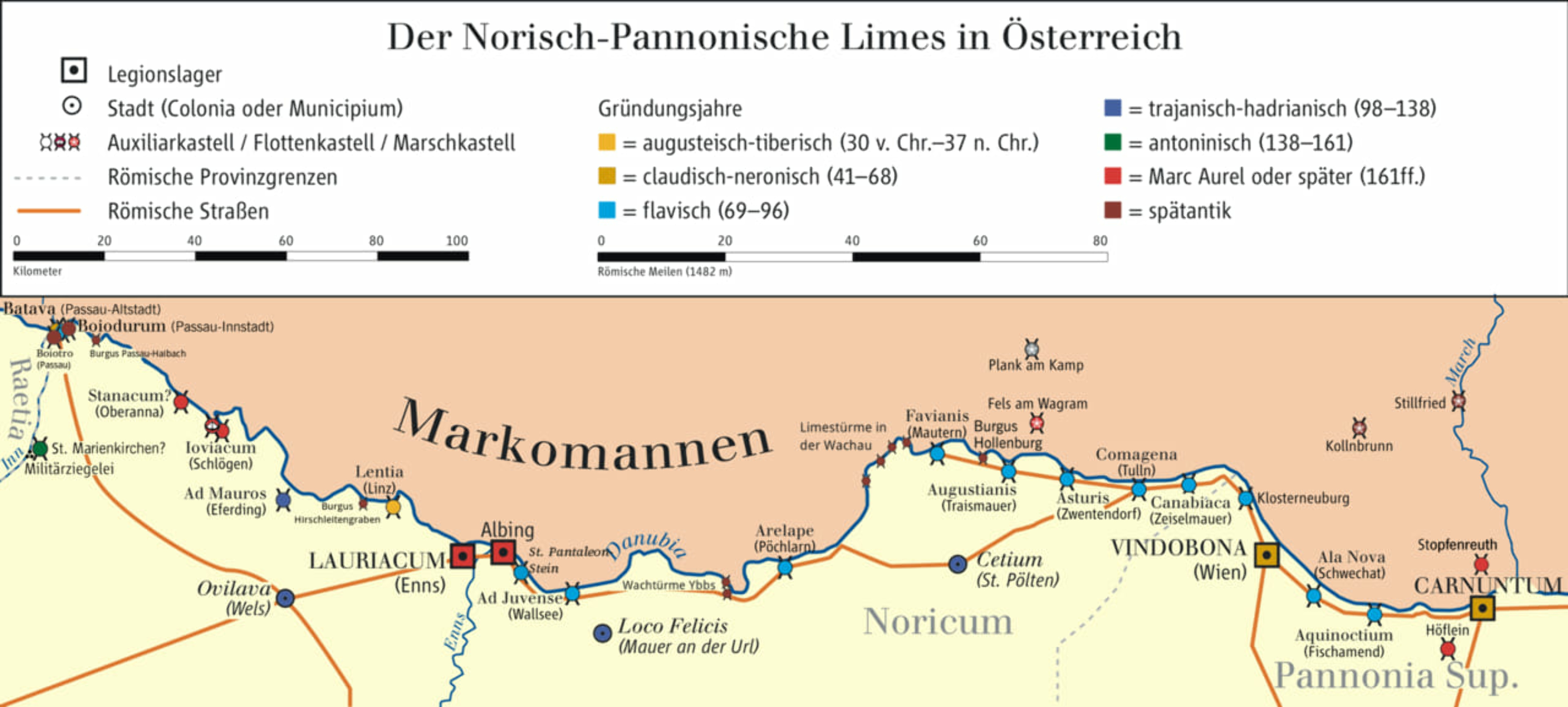
Itinerary for my march along the Austrian section of the Danube Limes:
11th May - Passau, Zollamt Achleiten to Oberrana. 25km
12th May - Oberrana to Hinteraigen. 19km
13th May - Hinteraigen to Wilhering via Eferding. 30km
14th May - Wilhering to Linz. 13km
15th May - Linz to Enns. 16km
16th May - Enns to Ardagger. 33km
17th May - Ardagger to Ybbs. 25km
18th May - Ybbs to Melk. 25km
19th May - Melk to Bacharnsdorf. 23km
20th May - Bacharnsdorf to Mautern. 15km
21st May - Break / Preparation for Documentary shooting in Carnuntum.
22nd May - Documentary shooting in Carnuntum.
23rd May - Rest / Repair day.
24th May - Mautern to Traismauer. 17km
25th May - Traismauer to Tulln. 30km
26th May - Tulln to Hadersfeld. 18km
27th May - Hadersfeld to Vienna. 20km
28th May - Vienna to Fischamend. 23km
29th May - Fischamend to Carnuntum. 22km
30th May - Carnuntum to Kittsee. 23km
A small update and reenactment reality check:
I am set to start a 350 km journey, on foot, in fairly accurate Roman military equipment, in a few hours.
I am not prepared at all.
I have spent the last week stoically crafting essential equipment which I didn't have so far, like furca, thin balteus, spear shafts, purses and net bags. Today I have finished a shield cover, which Peter Reinhard Hricak has generously helped me to make and I have riveted my new belt, which was crafted meticulously and sent to me today by Ezequiel Nicolás Baños Cacciatore. I have pestered and relied upon the amazing skill, work and time of these two great craftsmen, who have so vividly and selflessly supported me in my unprepared folly to launch myself into this adventure.
It's now 3am. Last night and the nights before I worked till 4 or 5 am and now I just finished closing the front split on my chainmail and adding two side splits, as evidenced on several surviving pieces, and to ease Evan Schultheis mind! (just kidding, I really want to try this side split thing now).
I got half my bag equipment in the post today, (generously sent and crafted by Ezequiel) and I have not yet experimented with it.
A cave of letters whole tunnel goat skin was provided by Jurjen Draaisma, and is also yet to be tested. No idea how to best set up the rig yet.
I am also still to finish my tarp and I have yet to contact all the museums and roman towns along the way, informing them about what I'm doing...
Feels slightly like I'm not totally ready. Perfekt!
Let's see how it'll all go!
Day 2:
The journey has started. With some difficulties as expected, due to the ad hoc nature of the undertaking.
The first kilometers were characterised by many stops, because I hadn't found the right set-up for my gear yet. I have never used a furca before and although I was concerned, that in combination with an oval shield it could get uncomfortable, I was surprised, that it didn't move too much. However, I'm now sure I packed too much equipment and all the weight was very badly distributed. I had to make always more and more halts towards the end of the trip, as my back began to hurt seriously.
When I arrived at the Burgus in Oberrana, night had fallen and to make a proper camp was difficult. So I set up camp between a few trees in proximity of the Burgus.
Unfortunately it started to rain as predicted around 2 am. My tarp failed and all my equipment and I got soaked. I tried to somehow make the best of the situation and I curled up under the shield. Of course that worked only so well and as soon as the day began to show some first light, I scouted the area for a shack.
When I found the shack, I made 4 trips back to the camp, in order to fetch all my dripping gear.
Now I'm sitting here, contemplating solutions and trying to dry some equipment and repair my linen tunic which ripped in the neck area.
I'll not be able to move much today in this weather and with the wet and even heavier equipment.
I think I'll try and get to a friend in the area and dry everything there and impregnate it twice more thoroughly with wax and oil.
After that I'll set off again with less equipment. I will not need the anyway useless tarp and under ground felt, as sleeping outdoors in this weather in now a no go and (!), would also not have been necessary in this area in the 4th century, with camps, burgi, cities, and inns lining the way pretty neatly.
At this stage I want to also express a massive thank you to Nova Roma and Attila Gonda, who are generously supporting me in this adventure and have provided some funds for me to cover some of the costs of this commemorative march.
I will later make a video on the Burgus and talk about the area and Prof. Ubl's link with it. All videos will be edited after the journey and compiled for YT.
Reports on days 4 & 5:
After a day needed to dry my equipment and rework some parts of the carrying setup, I set out again near Eferding, to reach Linz via Wilhering, 2 important Roman sites on the Danube Limes.
The first 5 km flew by quickly and I could feel the improvements made on the equipment. However, they were not good enough.... After 5km severe cramps in the neck and shoulder area were forcing me to stop again every 2 km for a short break or rearrangement. I still carried 35kg of equipment. The weight is normally no issue, but with an unsuitable and totally unstable system, it becomes a real challenge.
I made it to Wilhering quite exhausted. Wilhering was home to an important Roman brick manufacture in late antiquity, with most bricks in the area coming from this production site. Its main time of activity was between 350 and 400 AD.
From Wilhering to Lentia (Linz) the way led through a densely forested section of hills with steep cliffs ending directly in the Danube below. I had to make 8km on a very narrow path with a lot of muddy and folded sections, due to the heavy rains of the last days. I noteably slipped once and lost my javelin tip by Ibor, which really sucks. Someone may find it in the mud pond in a few 100 years. Next thing I had to crawl through a narrow rock formation, which is when my flask bumped mildly into one of the rocks and broke. I quickly drank up my remaining posca and then threw the clay flask against the rock. It was heavy anyway and fragile, so no further need for it. I hope to get a leather replacement soon.
The terrain was very rough with a lot of ups and downs and my equipment started to weigh really heavy on my shoulders. I had to stop every couple of 100 meters. I was getting extremely exhausted. My entire clothing was dripping from sweat (not just wet - I really mean dripping). Gladly there were many springs in the area where I could drink. I wouldn't have made it out of the forest otherwise. Half way through the forest I found the remaining foundations of a nameless Burgus, which overlooked the Danube Bend before Linz. Possibly manned by the LEG II Ital, who was responsible for the entire strech where I was walking so far.
When I finally reached the suburbs of Linz, I was appaled by the many steep hills, valleys and garden suburbs that still barred the way on the last kilometers. When I reached Linz effectively, the day was dawning almost and I was in severe pain everywhere. I knew I couldn't do another such day with the same setup. I decided to leave my floor blanket, and a few other not necessary items behind at a friend's place for the next day.
Today, I made my way from Linz via Asten to Enns (Lauriacum), where Prof. Ubl had his main centre of activities. I was accompanied by my girlfriend, by fellow reenactor Johanna Kuffner and her boyfriend from the German army.
Today's strech is the most important on the trip.
Enns was Ubl's Carnuntum, it was always said. This site is most inextricably linked with his name and legacy. (More details on his work there tomorrow, as we visit the museum!)
We made again good progress at the start, with 7 km coming in fast and easy. When we finally left Linz for good (Linz has a weird border - we left and re-entered it 5 times today), we were in for long, straight roads through fields and industrial complexes and shopping malls. Not a very picturesque strech. After the first 11km, we all felt blisters coming up. I used an old trick and just stuffed my shoes with cold fresh grass. Blisters were no big issue then anymore. However, my armour, shield and pack was as unwieldy and problematic as ever. I needed to stop with increasing frequency as my back wasn't taking the battering any longer. I am known to withstand pain very long and that I can walk through difficult stretches with sufficient zeal. However my body just wouldn't take it any longer. I fell 2 times as my steps where getting insecure from the exhaustion. After what seemed like an endless last 10km, with many short and painful halts, we made it to the outskirts of Enns. Here I noticed that my soaked, short linen trousers where starting to really irritate my inner thighs a lot. I knew I missed the moment where I should have taken them off. Now I would have to endure a really bad irritation on the inside of my legs for the next days, severely limiting my daily reach.
I must change plans. My initial distance estimations were based on my previous marching experiences in modern or much lighter or ergonomic gear. I knew it would be hard, but now it's downright impossible. The large oval shield and the many heavy items in combination with the heavy long hamata, are prohibitive atm. I am now quite sure, this is not how soldiers in late antiquity marched distances of up to 35km. I am not perfectly prepared for this march, that was clear from the get go, but I am well above average fitness and endurance levels and used to loaded marches. I know how to suffer. But this is not working. I really can't imagine a smaller, much less well nourished, individual of late antiquity, to be able to edure such strain for many days. I've been marching 200 kms in the Sahara, with indigenous people of extraordinary endurance and adaptation to the hard lifestyle of the caravans. I could keep up with them and outpace them despite carrying 20kgs, so no, I don't take the "but ancient people were so super strong and much better then we are today lalalalala etc. pp.". A lot of people in antiquity were malnourished and thus not as physically performant as an average modern, fit and well nourished person. More pain resistant perhaps, but not necessarily much more performant. (Remember the Marathon guy? He was the fittest guy in the Greek army at the time - and died after the run.) Anyway, I'm switching tactics. I'm going to make a few days in lighter setup, to make some distance, and then again a day here and there in heavier setup on shorter distances. Whenever I will find time, I'll make a proper run through my equipment.
At this stage I want to send a huge thank you to NOVA ROMA, who support this march with a fundraiser amongst their members, in order to help me cover some costs of the broken material! Gratus sum!
Report on day 6 & 7:
On day 5 I made it to Lauriacum/Enns from Lentia/Linz, wearing full armour, arms and back pack. I was motivated and accompanied by my girlfriend, by fellow reenactor and my generous host for the next 3 nights, Johanna Kuffner and by her partner Matthias. On day 5, I went to the excellent Roman museum of Enns, Prof. UBL'S Main legacy for the public. Many of the objects exhibited there where found by his teams and published by him. He was fundamental in the establishment of the museum catalogue and several expositions. The recreated Vexillae exposed in the entry hall, were designed and commissioned by him. We spent the better part of the morning and afternoon in the museum, filming and taking pictures. The catalogue of the museum is much, much larger than what is currently on display. I shall return soon and hopefully get a glimpse at some of the items not on display.
I was astonished at the particular wealth of objects dating to late antiquity. Most intriguing was a bronze cheek plate of a helmet dated to the 4th century, but which didn't correspond to any of the types I am familiar with.
Lauriacum was the main legionary fortress in Noricum and later Noricum Ripense. It was home to the LEG II Italica and maybe later to the Lanciarii Lauriacenses. 3 emperors have resided here shortly: Constantius II, Gratian and Valentinian II.
The camp was established in the early 1st century, after the first and to date biggest legionary camp on Austrian territory, was established at Albing. The camp at Albing was abandoned consequently after regular floodings of the plain likely made it unsustainable. Lauriacum is situated on an elevated plateau, surrounded on two sides by rivers. From here the LEG II Ital would operate a large strip of the limes, with countless Burgi and smaller forts, up to 150km up and down the river.
After we admired the museum thoroughly, we set off to a 10 km march leaving Upper Austria and reaching Lower Austria on the other side of the river Enns. There we fund the place where excavations confirmed the location of the first legionary camp in the area. I walked this distance in Campagi and without equipment as it was only a short walk along the river Enns.
On day 7, I set out with a new setup, trying to take most equipment with me, except for my chainmail. I carried shield, sword, helmet and helmetbag and a bag for personal items. After several discussions amongst fellow reenactors, I decided to try and carry the shield strapped only to my left shoulder and stabilising it with one hand. The position made the shield tilt a little bit and bought it into a position behind my left shoulder, which seems to match iconography from the 2nd century. I made sure to strap both my sword and my other bags across to my right shoulder. That way I reached a balance between the weights on each shoulder. I must say it worked quite well. I was pleasantly surprised. Neither did the shield move too much, nor did my shoulders feel uneven.
My first station was at St. Pantaleon, where a brick factory dated to the 4th century was found at diggs. At 15km from Lauriacum, it was likely a main provider of bricks for the area. I then walked on, into the wetland forests stretching across the vast plain I now traversed. I wanted to find the Burgus at Au-Rottenhof. I wandered across the thick green, jungle like vegetation, full of nettles, of the wetland forest. I checked on 3 different maps and oriented to the exact landmarks that should help find the Burgus. But he remained invisible. Likely overgrown again by the thriving vegetation. During my 2 hr search, I had to cross several small rivers, trying to leap across fallen trees. However one of the trees broke while I was on it and I fell into the knee deep water below. The second time I fell into the water was because I slipped on the wood laying across the canal. So I made my way back through the thick underwood, with wet feet and a lot of bruises from the nettles. Back on the road, I continued on to the next highlight, the castum of Wallsee, identified as either Locus Felicis (Ubl) or Ad Iuvense, in the Notitia Dignitatum. After 20km though lovely plains, fields and the flat Danube shores, I claimed the strategically placed plateau of Wallsee. All this time, I didn't have any drink or water with me, as my canteen broke 2 days ago. Also my furca had broken on the way to Lauriacum. So I raided the next shop immediately and drank as much liquid as I could, while sitting out a massive thunderstorm for about half an hour.
After the sky had cleared a bit again, I walked up to the local Roman museum, which unfortunately was closed due to the pandemic. PROF. UBL was involved in several excavations at Wallsee and wrote several publications on the site. He notably maintained, that Wallsee would be identified as LOCUS FELICIS (ND. 33,34). The debate is still ongoing.
After having filmed in the area, I continued my journey for the next 10km, to Ardagger. As I approached a shortcut I had scouted out on Maps, a hunter approached me and asked me not to enter the forest, as it would disturb the animals. I gladly obliged, adding several kms to my new route. After about 3 hrs, I reached Ardagger and was rewarded with a lovely sunset.
For this 33km section in wet shoes, I felt no complications and no end to my capacities. I felt like I could have walked for another 10 to 20 kms. I was glad to be hosted generously at fellow reenactor Johana Kuffners place again for the night. My feet showed the imprints of my Ramshaw laces quite dramatically when I took off the shoes. My Thorsberg trousers stood the test also wonderfully, protecting me from blisters.
A big thank you to all my supporters and for all the overwhelmingly positive feedback I am getting for this experimental tribute march. I hope I can do the Profs. legacy justice in my own way and I hope to bring more deserved attention to his work. Specially Enns/Lauriacum, will always be a shrine to his memory.
Report on days 8 & 9:
After having walked for 33km the previous day, with new set up, shield slung onto the left shoulder, bags on the right shoulder, no armour, I set out for another 30km today in the same fashion.
The way would lead me from Ardagger, along the Danube, through steep hills and cliffs near Grein and back into the plain surrounding Ybbs, which was the location of a burgus or a minor fort.
The new setup allowed me to have a quick start and I completed the first 7km fairly fast. After a break that ended up being longer than intended, because I got talking with another long distance walker, I found the next 15km not as easy anymore as the day before. My left shoulder started hurting from some sort of abrasion from the shield straps. Every time I had to correct the shields position on my shoulder, my shoulder got more and more irritated.
The landscape was absolutely beautiful, with islands in the Danube, waterfalls, and cliffs lining the way. What I couldn't transport in water, I took from the many springs along the way. The last quarter of the march was tedious and slow. I started to get some problems from my shoes and the tarmac that I had to walk on the entire day already. Changing my walking style wasn't helping either. I just had to plough through.
Arrived at Ybbs, I didn't spend much time looking for the Burgus, as it has not been found. The indications for a military building in the area, are many small items finds and dedication tablets, hinting at a longer military presence.
The next day, I made it from Ybbs to Melk via Pöchlarn, which was indeed an important fortress, town and fleet HQ. Under the command of the Dux Norici Ripenses and Pannonia Prima and operated by the LEGII ITAL, Pöchlarn is identified as ARELAPE in the Notitia Dignitatum and the Tabula Peutingeriana.
PROF. UBL was in exchange with the local museum and organised exchange of exposition items between Enns and Pöchlarn. It is noteworthy, that a unit previously stationed in Britannia, was likely shortly present at Arelape, since a votive stone was found, which is uniquely identical to one stone found in Colchester and which may have been made by the same master.
Approaching Arelape, I got stopped and invited by a bar owner (Hafenwirt) who was really enthused to see me. He had heard the news of my arrival at Arelape in the radio. Extremely hard hit by the pandemic measures, he nevertheless insisted on offering me the beers. I was really moved by this humble generosity.
On my way through the town I kept getting stopped by people who had heard or read of my journey. They were all really excited to see me and to take pictures. Many people even turned around their cars and drove after me, just to say hi! The most lucky coincidence was when the curator of the local Roman museum drove by and jumped on his bike to pursue me, in order to invite me on an exclusive tour of the very nice museum! We had a great exchange and I admired the finds in the small museum. Particularly fascinating was a typical lamellar, helmet cheek piece of possibly Hun or Avar origin. The local archaeologists and curators were totally in the dark as to the nature of the piece, identifying it as knee or shoulder armour part... I ensured them: this is a cheek piece.
Arelape is situated at the confluence of river Erlauf and Danube and an important transalpine route.
After many more nice encounters, I continued on through thick wetlands forests and onto the imposing plateau of Melk.
Melk hosts one of the largest monasteries in all of Central Europe. It is lower Austrias biggest tourist destination. Despite ideal location, there are no Roman sites to be found underneath the baroque monasteries foundations.
I hope you liked today's report! In the next reports I will go into more detail on my equipment and its damages so far sustained. At this stage another big thank you to NOVA ROMA and their support for my march, as well everyone supporting me via Patreon https://www.patreon.com/projectquartodecimani
A lot of my equipment is going to be destroyed during this experiment and so I am glad about every help and support I can get.
Report on day 10:
Today I walked in full gear again.
I wore full armour, protective surcoat, shield strapped to one shoulder, arms, and bags strapped to the other shoulder and I wore brand new, experimental caligae, made by Martin Moser, based on iconographic evidence from the 4th and 5th centuries.
Now, superficial common sense and experience would say: "don't attempt a full march with brand new, totally hypothetical, leather sandals." However, that's not how I think and that's not how things necessarily work in my experience. I looked at the caligae, checked them out and I knew they would likely not make a problem with blistering. I strapped them on, put on my armour and started walking. Trusting my guts and my experience. I was right. I had not one single spot likely to turn into blistering after 10km. They feel tailored perfectly, light, ergonomic and sufficiently protecting the lower edges of the feet. The only issue I would have with this particular design, and this comes from 16 years of experience as a soldier, is that they take too long and are too complicated to put on. The very long strapping is quite difficult to handle. So my verdict on day one is, that they certainly performed well and might be a great choice for officers which have the luxury of fashion and time on their side, but for a normal soldier the concept would need slight adaptation. I imagine, that if the lace holes currently placed at the lower edge of the caligae, where formed into longer cut outs or loops that would go over half the wrist of the foot, then being tied by shorter lacing, it would be similar in comfort, but much faster to put on. Being able to put shoes on fairly fast, is one crutial element for soldiers.
My new shield and bag carrying method was still largely preferable to the old reenactorism of strapping the shield on like a back pack. I even suspect from iconography there could have been quite clever strappings in late antiquity, stabilising and supporting the left shoulder as main support of the shield. More on this in later posts.
The chainmail was indeed again slowing me down and weighing heavy on my neck after a while. However, it was not comparable to the first days, where it was really painful in combination with the Rucksack method of carrying the shield. My conclusion therefore currently is, that neither armour or shield by themselves where the source of my severe strain in the first days, but that it was the combination of these two, in an ultimately unsourced and harmful way of carrying them.
The journey itself led me from Melk, via Aggstein to St. Johann im Mauertale. I got again stopped regularly on the way by people and even some army comrades who wanted to take some pictures. One of the people stopping to talk to me, was the Manager of Castle Aggstein and Schönbichl. He had heard of me via the living danube limes project and was very interested in my further concepts for a sustainable historic tourism infrastructure along the Danube.
Let's hope for some fruitful cooperations in the future.
After about 10km, walking mainly on tarmac, my feet and legs started to hurt from the weight I was carrying. This slowed me further down.
I reached St. Johann im Mauertale around 18h. The shoreline Road ended there in historical times and transfered to the hinterland of the Dunkelsteiner Wald. Traces of the Roman roads are still visible there. It was only logical to have a burgus at this location. And indeed, the local church shows signs of having integrated remains of the Burgus into its stone works. The name "Mauertale" further suggests presence of a Roman building, since Mauer means wall and may be sign for older Roman ruins having been present. (See also Traismauer, Mautern, Mauerbach, Zeiselmauer).
3 days break from the march - not to relax, but to shoot a documentary on the Romans in Ovilavis. A short report and reality check:
I have walked in Roman gear daily for the past two weeks, in order to honour a late researcher, to promote the Danube Limes and all its hidden potentials and treasures and in order to test highly accurate kit on coherence and battle readyness. Of course I feel reasonably tired from this. I had to halt my march this weekend, as this Saturday was the only viable date to shoot a few living history scenes for an upcoming and very promising documentary about the Romans in the area of Ovilavis, today Wels. I had the pleasure to be moderating in the documentary and to help with organisation of some of the living history scenes illustrating the experts elaborations. My friends from the very dedicated and talented Film team of Netta Mea are doing an excellent job and I am really looking forward to the result and future projects!
Now, what does it mean to "help organise a few living history scenes"?
It means to find sufficient reenactors with equipment for 1st and 4th century military and civilian displays, who are able and willing to participate in a project which relies mostly on voluntary work and enthusiasm for a good depiction of our Roman past. It means to bring all of your equipment to fit out those that don't have any equipment or that need to borrow equipment in order to play certain roles. It means to pack your car for several hours, despite being tired from marching for 2 weeks already, it means to get your equipment used and partially deteriorated during shooting, it means stress when people don't know how to put stuff on and you need to make sure no one breaks your expensive shoes or handwoven tunics, it means you get everything back dirty and you will have to wash it, it means being stressed and last to leave because you brought the most stuff and need to collect it again and pack it all up, it means getting home late and needing to unpack everything for several hours, it means dealing with those that are frustrated because you forgot to tell them about the shooting because you are actually doing an ad hoc 350 kilometer march and have your head slightly somewhere else, it means having to justify yourself for attempting to do everything despite timing perhaps not being great for you yourself, it means not getting enough sleep and still having to function the next day back on the march and it means people getting angry at you unequivocally for various reasons, because you are trying to do more than what they would ultimately be willing to do from within their comfort zone.
Note: I am not complaining! All this is normal and human and to be expected when you try to do get many great things done. It's ultimately always a gamble. Either you got more people happy with you at the end of the day or you got more people angry with you at the end of the day. You'll rarely have everyone's favour all the time. What's important for me, is that those people who I really care about, are predominantly amongst those who are happy with my actions at the end of the day.
I can't be everywhere and I can't be everybodies darling all the time. But I'm trying my best - even for those that would under normal circumstances not deserve my best. As long as that is remembered and as long as the efforts I'm constantly making for others are being recognised, I'll bear complaining with benevolent ease. However, I won't tolerate mischaracterisation of my motives and my altruistic nature.
Reenactment brings people of many different walks of life together and it can be a real joy to create occasions together. It can also be a challenge of course and people like myself, who are in very exposed positions, can easily become the subject of controversy. It's affecting. I just want to take a moment, to remind people, that this exposed position comes automatically when you are very active, no matter if you are actively seeking visibility or not. The negative sides of that exposure can be very detrimental to the psyche and it needs robust nerves to withstand frustration and anger.
On a positive note however, we had a lot of fun shooting and I am looking forward to the final product with confidence.
P. S. : to add to the reality check. Despite the fact that I seem well equipped and always busy with various projects, I am in a very difficult position. I'm not making a secret of it. I am a musician by trade and due to the pandemic I am currently unemployed. In my current march, much of my carefully assembled gear will be deteriorated or even destroyed. I believe that a lot of insights can be gained on late antique Roman soldiers equipment through my march. But I want to be honest, I won't be able to replace much of the destroyed equipment currently. I can only hope for the support and generosity of those that understand and appreciate my work. I am getting some generous support by NOVA ROMA, but I will likely remain unemployed for several months and the future in the music industry looks bleak also beyond the current emergency measures. I'll be very grateful for any support via my Patreon page, as it allows me to do work, which may actually create work places in the future. Some of my ideas have already created work places and income for up to 10 people in several countries. Ironically my idea that brought others a living, has brought me only despair so far. The Danube Limes has great potential. It is my mission to make this potential visible and to push its development. You can help me on this mission here: https://www.patreon.com/projectquartodecimani
Report on day 11:
Today was hard. I'll admit it. It wasn't the distance of about 23 to 25 km in sometimes steep terrain, or the weight of my full armour and equipment, this time it was a weird pain I suddenly developed this morning in my right foot. The pain grew harder after 7 km and after each break I felt like I shouldn't continue if I want to be able to walk again the next day. At every step my foot felt as if my toes where broken. Severe pain shot right to my brain every time I set my foot on the ground. I had to completely alter my walking to be able to plough through. The new way of carrying the equipment worked reasonably well again and it would have been an enjoyable day, had I not developed this strange pain.
I was accompanied today by the really friendly and super dedicated young 1st century group "Ursi Aurei", hailing from Aelium Cetium. They stoically walked the way with me in full equipment and despite all the struggles with rain later in the day, we all made it to the Roman gate of Traismauer.
Also with me was the ever positive Andrea Höller, who bossed the walk without problems!
The big highlight of today, was the horse drawn cart of Bert Riken that joined us! It is so interesting how such a cart changes many dynamics! We had to cut ourselves through small paths along the Danubes side arms and had to think everything a little different from before. I will report more on this in the coming days.
We had a great day, with much laughter and also much sweat and complete exhaustion at the end of the day! We met many good friends and supporters on the way, like Klaus Michael Nedelko and Rudolf Unfried and we were invited to some glasses of locally produced wine by several lovely people on the way!
Well done to everyone who participated and made this journey special!
We are sleeping tonight in a real modern villa rustica, although, since it is fully occupied, we sleep in the straw of the stables. Good enough for me! I am completely exhausted, in pain everywhere, I can't stand on my right foot at all and I have shivering fits and a cold from wearing sweaty clothes all day. I only slept for one hour between yesterday and today and I'm not sure in which state I am going to wake up tomorrow.
Fingers crossed that this is not the end...
Report on day 12:
The end of the walk, the saving of the journey.
I have a stress fracture on my right foot. I walked 26 km with that stress fracture and full armour and pack. Now my right foot is completely swollen and I can't even stand up on it anymore. Apparently I went beyond what my body can handle as a modern person not used to this kind of stress.
However, I'm not giving up. We got a horse drawn cart and we got the will to use everything in our arsenal in order to go as far as possible.
After sleeping little and uncomfortably (due to pain and cold) in the stables of a true villa rustica (Schweizerhof - an amazing eco- and horse farm project who welcomed us on short notice with incredible open arms and friendliness!), I woke in an amazing former Rothschild residence near Augustianis! But I also realised that it was 04h00 in the morning and I had not slept enough, just like the last days. I couldn't fall back asleep and my mind was spinning around my injuries acquired the previous day.
When I got up I noticed the intense pain in my right foot again. It's gotten worse. My foot was indeed completely swollen.
Trying to get up and walking was quite a challenge. After a few very painful attempts to walk, we saw that we wouldn't be able to reach our today's goal of Commagena, Tulln. So we packed the cart in a way, that I could also sit on it and we drove the distance of 27 km in about 4 hours. It was an amazing feeling to be working with an animal such as Rufus. Calm and very confident he pulled the cart without problem and he enjoyed the day. Without him and Bert Riken, my journey would have had to halt for a few weeks. Like this, I may be able to make it to Carnuntum.
I have never had a fracture in my life before. I still don't want to believe I have such an injury, just from walking....
I want to thank all the people who support me and follow me on this adventure. I'm not giving up yet.
Reports on days 12 & 13:
After the march from Favianis to Augustianis and half way to Asturis, in full equipment, I injured my foot. I walked 26km in full armour, with baggage, over steep hills and through riverine plains. I was accompanied by 3 legionaries and a civilian from the great group Ursi Aurei from Aelium Cetium, as well as the horse drawn cart of Bert Riken, with their loyal animal companions Rufus the horse and Frieda the dog and our ever positive and cheerful Andrea Höller. We started in front of the walls of old Favianis. The same walls that gave protection to St. Severin during his struggle to maintain order in the waning days of the Roman order in Noricum. Journalists has gathered to interview us and to take pictures. I am really grateful and happy for the tremendous interest the present reporters had in us and the respect the newspapers showed towards our activity. It had a resounding echo in the population as the next days shall show!
After starting to walk, we immediately noticed, that the presence of the cart made everything different. We couldn't walk along the initially planned route, as it wouldn't be suitable for the cart. We had to improvise and rely quickly on local guides.
Not far from Favianis, we got stopped in the next vicus, by one of the reporters. She invited us in to her garden and her family and her prepared a lunch feast for us and the animals! Also a very famous wine producer of the region (Nikolaihof), who currently hosts some roman excavations on his property, came along to gift us with 12 bottles of his finest! We knew now, we where the guard units of an important wine transport of supreme quality, for the tribunes of the coming forts!
Continuing up some steep hills, we found that the cart needs to be speeding up the hills, as this is more economical for Rufus. After crossing the first range of hills, I felt that the little pain I had in my right foot since this morning, had developed into a serious sting. I started limping. When going down the hills, we occasionally had to pull back the cart in order to help Rufus break and slow down. The cart has no breaks and is relying solely on the horses power. When the horse starts slipping on steep roads, it needs all the support we could gather.
Reaching the top of the second hill range, we got invited by local wine producers again and were gifted further bottles and Rufus got his well deserved beer! Joining us at this joyful occasion, where our friends and supporters Klaus Michael Nedelko and Rudolf Unfried, who are ever fighting for our Roman heritage in the region! It was a truly joyful meeting!
After departing the lovely hills between Favianis and Augustianis, rain set in and accompanied us all the way through the plain of the river Traisen. The pain my right foot caused, was by now reason of concern for me. I have known pain from marching and exhaustion, its nothing new to me I would say. So I knew, this type of pain is indicating a longer lasting problem. I was increasingly getting worried about the immediate future of the walk... I knew I would make it till this evening, but I felt I would wake up to an injury that would not just go away after a few kms.
Arriving finally at Augustianis, we all marched through the pristinely preserved Roman gate from the 4th century. It was a moment of triumph, despite the rain, and of relief. Everyone was visibly happy to arrive.
However, for me and the horse cart, the journey wasn't over yet. We still had 6,9 km to make, in order to arrive at Schweizerhof, where we would be welcomed for the night.
After making it out of the vicus of Augustianis, Bert noticed my deteriorating ability to walk and he told me to sit on the cart instead of him. I happily obliged despite initial protest. I knew it was the right thing to do after all.
The day dawning in the vast grey of a rainy sky, we made it to the confluence of river Traisen and Danube. A beautiful forest and small tracks initially gave us a romantic impression of past landscapes. However, the jungle quickly grew thicker and the track more narrow and unpassable. I left the cart again and walked in front of it, making way through the thick vegetation with my Spatha. We still had 3km to go, when at one point an ancient and overgrown metal barrier barred the way. Only a small, crooked and very narrow path led around it. We chopped branches and bushes out of the way before attempting to cross this narrow point with the help of Rufus's amazing precision. The 11 year old Freiberger horse listened to Berts commands on point and pulled the cart through with only millimeters to maneuver sometimes. An amazing feat!
Arriving at the amazing and luxurious Villa Rustica of Schweizerhof, we got welcomed very warmly and offered soup by the chef of the house, who turned out to be one of Austria's most coveted Asian cuisine specialists. We slept in the hay of the barn after a truly enjoyable drink with the visionary owner of the place and I felt my foot had a bigger damage that what I had maybe thought initially.
Sleeping uneasy, I woke up many times and wondered how I should continue.
The next day, after an amazing breakfast invitation by the generous owner of Schweizerhof, we decided to pack the cart in a way, that I could sit on it too. It would be a maximal charge for the cart, but if well balanced, it wouldn't affect the horse much in flat terrain. Indeed it worked and we were off across fields and through small towns. I was amazed at the speed of the cart, even while just walking at Rufus's own speed. We averaged at 5 to 6 km/h in walk and 10 to 15km/h in trott, making us reach Zwentendorf (Asturis) in about one hour. There we were royally welcomed by archaeologist and culture connoisseur Klaus Nedelko, who made a wonderful Risotto for us and with whom we exchanged about the difficulties one can face on the Danube Limes, if one tries to bring Roman heritage to new fruition. As always, it is missing education in certain matters that makes great plans come to a premature halt.
After the really agreeable stopover, we made it to Tulln in under 3 hours and brought Rufus to his quarters for the night. We were welcomed by the Reitclub Tulln, where we created a little turmoil amongst the local horses upon arrival. Afraid of the knattering wooden cart, two elegant and huge horses, jumped over their fences in panic and fled in direction of the inner city. Fortunately they could be caught quickly and brought back to safety.
The day ended with a nice dinner and a really swollen foot.
I was amazed at the speed of the cart and how much of a difference in my perception of space it made between knowing that I have to walk and knowing that I can drive to a location in the distance.... The Roman empire still seemed huge, but with the cart it suddenly didn't seem as overwhelmingly huge anymore...
Report on day 14:
The previous day we arrived in Tulln, ancient Comagena, location of one of the headquarters of the Danube Fleet.
Tulln is located in the middle of a flat plain, which hosted 4 garrisons. Augustianis, Asturis, Comagena and Cannabiaca. Most of whom where cavalry garrisons. The municipium of Aelium Cetium, further inland, was the main town in the area.
After preparing the cart and Rufus again, we got contacted by the owner of the stables where Rufus spent the night and it turned out that she was the wife of the ex-mayor of the town. Her husband wanted to meet us before we headed on. He was the mayor responsible for the building of an exact copy of the Marcus Aurelius of the capitoline hill. The monument stands 6 meters tall on the shores of the Danube and watches over the ancient border of the Roman empire. The old mayor also oversaw the restoration of the only surviving tower of the ancient roman garrison - which was conducted in cooperation with Prof. Ubl who was the scientific advisor. The tower stands proudly next to the statue of Marcus Aurelius.
As we had a press fotoshooting next to the statue, we used the opportunity to visit the new exhibition at the Roman museum of Tulln. A really great museum to visit, with lots of great finds!
After the visit we trotted on with Rufus, with all 3 of us sitting on the cart. There wasn't much space, but it was the only chance of making it. My leg was still inflated and hurting and it wasn't clear what I had done to it. I was in exchange with several doctors in my friends list and they all agreed that it could be several things, but that a stress fracture could be likely and that I should make an x-ray asap.
Sitting on the middle part of the cart, I had my right leg dangling out at the side and over the wheel. I had to watch out not to get caught by the moving wheel or to fall off the cart when the road got bumpy.
We made it across the damm protecting the plain from flooding, until we came to the location of the garrison of Cannabiaca, my home garrison. Zeiselmauer today, hosts the only fully preserved Burgus in the world. We made a break there for lunch and where eagerly welcomed and questioned by local horse riders. Their horses where less happy to see us, as they where again scared by the cart.
After a lunch break we continued swiftly on the shores of the Danube and made it to Prof. Ubl's home at Kritzendorf. The plan was to visit his relatives and daughters still living there. However an accident would prevent us from following our plans...
Amidst the small roads of Kritzendorf, cramped between the steep hillside and the Danube, we let Frida the dog run freely. She is very well behaved and always stays close to the cart and listens to commands instantly. Since there was no traffic in these side roads, it seemed like a safe thing to do. However, two dogs in a garden started to suddenly bark at her and she got distracted for a second. In this second she didn't watch out for the carts wheels and one wheel drove over her left paw.... She started screaming and squealing and immediately jumped up to Henrike who was sitting at the back of the cart, seeking help. She didn't understand what happened and was in panic. We stopped the cart immediately and placed poor Frieda on the front part of the cart and calmed her down in order to inspect the wound. She had an open fracture of the paw. I called my father immediately, since we where far from a veterinarian and our house sat just on top of the hill where the accident happened. We then found a veterinary that was open and organised transport of Frieda and Henrike with my dad. In the meantime, Bert and I where scouting for a nearby camp to stay over night, since we wouldn't be able to make it to any stables. We found a good spot in the wilderness of the wetlands and started to set up camp. It wasn't without difficulties, since there were many poisonous plants in the area, which Rufus shouldn't be able to reach. We established a perimeter for Rufus with ropes, in which we eliminated all poisonous plants. Our main problem now was, that it wasn't easily possible to drive to the camp with cars. After a bit of trickery and liberal interpretation of forestry laws, we managed to bring the car to the camp and unload Frieda, still dizzy from the operation. My parents where so nice to supply us with some food for the night and we went into an uneasy sleep, since Rufus escaped several times during the night. He was wearing a little Bell, so we knew when he was getting too far away.
Day 15:
The next day we packed the up the cart which is a genius construction and we went on our way direction of Klosterneuburg, which may have been Arrianis, but that identification is not yet really secure. The emplacement of the ancient garrison was over built by subsequent medieval and barock structures of the majestic monastery there. On the way through Klosterneuburg, we got frequently stopped by enthusiastic locals and we got invited again to drink and food! A highlight for the locals, was Rufus drinking his beer!
After 2 hours, we had reached Vienna. Ancient Vindobona, the place where Marcus Aurelius wrote much of his contemplations and where he may have died, was already important in antiquity. Less important than Carnuntum for most of its existence, it gained the upper hand in the later 4th century, when the Danube fleet command of Carnuntum was transferred to Vindobona. The strategic emplacement of the city would just prove to be superior.
Initially, we thought to cross the city next to the Danube canal, coming by the exact location of the ancient garrison at the inner city. But we opted for the safer bet with the cart, following the main cycle road along the main arm of the Danube. We crossed the city in a little over one hour and reached our host for the night, the military riding club in Prater Park (we actually composed a tune about that park with my band Fourth Moon, which you can hear here: https://open.spotify.com/track/4jZtRd8xGax2DiPagzo9mD... ).
We were welcomed by a fellow officer of the Austrian army and hosted royally. We had a grill session and exchanged stories of our adventures. We even got Rufus into the riding hall and I took a turn without saddle on this majestic horse. I have been riding since I was 7 years old. I have sat on many problematic horses and have never fallen from a horse, no matter how hard they tried. It was a real irony, that today was the first time I fell from a horse! Rufus wide back and his energic Trott made for a really challenging surface to sit on. I just slipped to the side at some point and had to jump off!
After a visit by my girlfriend and a short walk through the ancient woods of Prater Park, I noticed, that my foot wasn't swollen as much anymore. I could walk with much less pain then the previous day. Consulting with some doctors in my friends list, we came to the conclusion that perhaps a stress fracture wasn't the most likely diagnosis after all... It may be an inflammation of the tendons and or the joints. Not pleasant either, but nevertheless a whole different situation after all. I would watch the development over night.
I want to thank at this stage again my parents, who helped so much and so quickly in these days as well as Bert, Henrike and Rufus for saving my journey and all they have done for me, I want to thank our host of the night, Daniel and his team at the HRSV Wien and I want to thank the members of NOVA ROMA and all my supporters on Patreon for making this adventure possible!
What I learned during these two days was once more, that the body can heal fast. That less food can help on a journey to focus and to get rid of civilisational excess kilograms. ^^ I learned to appreciate the power of a cart, that gives not only transport relief, but speed. It also makes a huge difference, if you are accommodated at night and have a bed and a roof and a shower, as your material and yourself of course deteriorate much less than when you camp out several days in a row. When camping out in the wild, I use only a blanket and my military cloak. Nothing else. I try to stuff the ground below me with plants and grass for better insulation. But it rarely is enough for a thorough sleep. I mostly sleep 4 interrupted hrs when on the ground and outside. It accumulates over the weeks.
Keeping gear and body in shape is also not as easy as it could seem if you are an experienced outdoor person, as you have to dedicate time to the animals and the cart. You don't have the luxury of time to take care of your appearance and clothing as much, specially if you are camping out in areas, where it is normally not allowed. You just need to break camp quicker and can't fiddle around too much.
Report on day 16:
Arrived at Viennas Prater Park and accommodated by the Heeresreitsportverein the previous day, we started the new day by preparing Rufus the Horse and our cart for the next journey to Aequinoctium / Fischamend.
After strapping poor Frieda the dog to a safe place between the drivers legs, where she could rest her injured paw, we started to roll over busy industrial streets near Viennas danube Harbour. Cars and trucks where rolling past us at Great speed, but everyone was happy and joyful to see us and every truck driver shared a smile and a waving hand with us. It was truly mesmerising to see how much positivity and joy we received from everyone that passed our way.
After reaching quieter Danubian shores again near Mannswörth, we noticed, that the carts left wheel was severely damaged. It had taken a strong hit the previous day when Rufus backed up from an unknown noise of an anchoring ship and drove the wheel into a concrete pillar by accident. Also the overweight on the cart played its part in ruining the wheel. From now on, we had to all walk. It would be too dangerous for us and the animals to risk a breaking wheel and a collapsing cart.
So we marched again. My foot felt a little better, confirming my suspicion further, that it actually isn't a stress fracture, but more like a strong inflammation. I walked slowly and had to catch up with the cart frequently.
We came through stunningly beautiful Danubian landscapes amidst the nature park Donau-Auen. The intense green, the many side arms of the Danube, the old ad huge trees and the many animals that crossed our way, would suggest that we were far from one of Europe's biggest cities and its adjacent airport. But in fact we were right between the two.
The combination of Nature Park and airport, is a bad one though for historic means of transport.... The ways we're frequently blocked by barriers and fences.
Annoyed by the oftentimes senseless barring of ways, Bert and I decided to bring a historic solution to modern nuisances: we unblocked the roads by force! Taking a hammer we pushed out pins and took apart barriers and put them back together after crossing under the eyes of bewildered Airport firefighters. They had no arguments, as the barriers are only for cars, motorcycles, bikers and riders. But not for horse drawn carriages. This detail is not in the regulations....Folk just aways forget historic means of transport, thinking they do not exist at all anymore.
The next barrier was near a passage under the motorway. The metal barrier didn't block the entire way, but some big stones or boulders where placed in such a way, that no vehicle could drive around the barrier. So we decided its time for Rufus to show us his strength. We built an improvised towing system and attached the stone to Rufus's lorinery. After a few minutes the stones where out of the way and Rufus got his well deserved beer. We passed all obstacles and left no damage. Thus the small triumph of living history over the spirits of modernity motivated us to continue our journey with fresh power.
Reaching Fischamend, we visited another vet, in order to change Frieda's bandages and look after the wound. After that, we walked on to the area between Fischamend and Maria Ellend. It was hard to find a good camping spot in the wetlands of the Danube, but we eventually found a magical place, offering sights as they would have appeared in antiquity!
Preparing for the night, we secured the perimeter for the animals and set up a small campfire next to the water. During our dinner, small water serpents approached the shore only to be discouraged to come ashore by our fire.
The night was short and hard for me again, as I felt that my military Chlamys was too small for me to comfortably cover myself fully with it. Every minor movement at night uncovered some part of my body and I woke up from cooling. Also the ovoid shape is inconvenient as the edges of the cloak are long and too thin to serve as cover.
Day 17:
Waking up very early between 5 and 6, I felt like I just didn't have the right sleeping equipment for such nights. Every fool can be uncomfortable outdoors. It's to stay comfortable also with little that is the art. I need to find out better ways of using my gear of I want to truly be comfortable in the future.
Packing up the camp took about one and a half hours that morning and we set out to walk the last day that the horse drawn cart would be joining me.
We all walked till Maria Ellend and then into the Nature Park Donau Auen again. In the middle of the park we got stopped by a ranger who was amazed at our undertaking. He told us he wasn't sure if we are actually allowed there with the horse and cart, but he said he thinks we are doing no harm what so ever, and certainly less harm than the cyclists who cross the park incessantly. So he left us head our way and even told us where the best route to Carnuntum was. A great display of pragmatic realism! Why are there not more such people in positions of responsibility?
In the park, we had to cross flooded bridges and old sections of the road that was used for centuries to tow boats upstream. As beautiful as it was, we were constantly nervous because of the damaged wheel.... If it broke in the middle of the park, how would we get all our stuff out and near a road?
Fortunately the wheel held and we left the park. After crossing endless wetlands and forests, we crossed endless fields and got stuck in several dead end roads. Navigating through fields we reached the road to Carnuntum again. At Regelsbrunn, we were joined by Peter Reinhard Hricak from Slovakia, who came out in support and who brought us drink and food supplies! We continued the journey the merrier in good company and had great talks about living history and the challenges of the modern world in relation to historic modes of traveling!
After 17km the majestic Heidentor, the symbol of Carnuntum, a triumphal arch probably erected under Constantius II., greeted us from a distance. Its sight almost brought tears to my eyes, as I couldn't believe that I truly made it to here on foot and horse cart.... I was thinking back to the beginning of the journey, in the dark valleys near Boiotro / Passau, the faraway lands at Schlögen, with no friends and family nearby and exposed to rain storm and cold and the overwhelming feeling that I took a bite too big to chew in the end. I thought back to the endless days between Eferding and Enns, where the equipment weighed me down so much that even 15km seemed like an eternity. I thought back to the long stretches between Enns and Ybbs, where I finally felt like I was living up to my usual pace and distance with several 30 to 35 km days in a row without problems. I was thinking back to the trying experiment with new caligae and full equipment, where I barely made 12km and set the stage for my later injury. And the endless distances in the Tullnerfeld, which I could not have mastered with my injury, without the help of Bert Riken and Rufus the Horse.... All that came back to my mind as we approached the triumphal arch on a sunny and glorious day. My foot was hurting a lot again and I was barely able to walk, but I had my dear living history home just in front of me. It was truly a feeling of coming home. At the Heidentor, we were welcomed by the Duke of Abensperg-Traun, the owner of the land under which most of Carnuntum lays dormant. He welcomed us and Rufus to his magnificent stables and property just outside the museum walls.
When I entered the Villa Urbana of the museum however, to rest from the day, it felt like finally arriving in my own 4 walls. I put my bags down, took my shoes off, lit some incense and stretched out on the bed in my little green room and I fell asleep within minutes.
A massive thanks to all my supporters on this journey, specially my friend Amin Milites, who really generously supported me (Amin, you are mad! ) and who is the historic chef you always dreamed of meeting! I don't know how I deserved his and the other supporters kindness, but I am deeply thankful!
Also a massive thank you to the Duke of Abensperg-Traun and his team, which provided the best place for Rufus, who felt visibly joyful!
Report on day 18, the last day of the trip:
Arrived at Carnuntum the previous day, I felt rested and motivated to complete the journey now.
Bert and Henrike where already disassembling the cart and preparing Rufus for the voyage home, visitors were starting to populate the Roman streets of the museum, and I was trying to organise the day. I had press appointments, a visit at the auxiliary cavalry camp of Carnuntum, several friends who wanted to accompany me and also transport back home to organise. Amidst all of this, my right foot felt quite bad again from the last two days walking. I wasn't sure how far it would take me today but I was determined to reach the border no matter what.
As I finally was set and everything was organised, I wished Rufus, Bert, Henrike and Frieda farewell and organised a few apples for our great horse friend. Without them, my journey would have been interrupted for a week at least or even over.... I am deeply thankful for their tremendous effort and commitment to this adventure and for the jolly time spent together! I will certainly visit them in Germany, come time and plot more adventures!
When I finally made it to the Auxiliarkastell museum, I was one hour behind schedule, which is unfortunately something that can and will always arrive on historic journeys. In history it was totally normal to have a certain flexibility when it came to rendezvous, as historic modes of travelling do simply not allow for modern expectations of punctuality. (I know, coming from me this sounds like a lame excuse, but I'm serious here! It is like that!)
Arrived at the Auxiliarkastell, I couldn't believe my eyes, as a whole host of people, local and from far away, had gathered to stage me a resounding welcome! Despite my considerable delay, the atmosphere was great and I couldn't believe how supportive and cheerful everyone was!
I got so many drinks and food offered, it started to become a logistical problem of transport!
The following tour through the museum, which I hadn't seen from the inside before, was shedding a lot of light on the often poorly highlighted Auxiliarkastell. Home to up to 500 riders between the 1st and later 2nd century, it got likely abandoned or reduced in size sometime between the later 2nd and mid 3rd century. It's water and sewerage systems are partially preserved under the museums building and can be seen in the basement. A local geographical given, made it necessary to lead used and sewer water over the fresh water canal system. Something Roman engineers would never tolerate, unless
... Its absolutely without alternative. Because this is such a rare find, where engineers and planners saw no better alternative, it is also a particularly massively built canal intersection.
After the visit, I was joined on my further march towards the border by fellow reenactors Andrea Höller and Róbert Martin Hudec, as well as by my girlfriend and a friend of her.
We made it to Bad Deutsch Altenburg, crossing fields and we stopped at the reconstruction of the monument to Jupiter Optimus Maximus, which once stood in a nearby temple that now got destroyed by a mining operation. A really poor decision in the 70s, which now is greatly regretted...
Via the splendid Museum Carnuntinum, we made it to Hainburg and via the oppidum of the Boii on the Braunsberg we made it to the Co fluence of river March and Danube, which is the border to Slovakia.
This last section felt very easy and light, as I was in great company and we also enjoyed great weather. Sitting into a car after all this trip, driving back west, along all the locations that I had just days ago passed under great effort and that seemed so immensely big, was a truly strange feeling. In my head the landscapes wouldn't shrink to car user size again and I marveled at the distances one could walk within a few days and drive within a few minutes.
My foot seems to have suffered more from the last 3 days walking again, but it was worth it. As I write these lines, 4 days after completing the march, I still feel my foot being strained and not ready for normal use. However, I am already on the way to the next adventure. At 18h today I passed Paris by car and I am on the way to the Atlantic on the continental far west...
I am immensely grateful to all my supporters throughout this march, without whom I could not have made any stretch of the way:
Peter Reinhard Hricak, who selflessly helped me make a great deal of my equipment in the last seconds before I marched off. He sourced and provided material and time and helped me make my furca, my shield cover and many more essential items.
Ezequiel Nicolás Baños Cacciatore, who made me equally essential and absolutely high quality replicas of various bags and belts, that served me greatly! He jumped into the adventure with the same enthusiasm as me and I am going to make a review of all the material in depth once I return from Armorica.
Bert, Henrike, Rufus and Frieda, who accompanied me and provided me with transport, food, drink, shelter and company and came all the way from Bavaria!
Johanna Kuffner and Matthias, who accompanied me and offered me accommodation and transport as well as super effective press support!
My friend in Linz, who offered me a brilliant place to sleep and some deerly needed Beverages!
My Friends Tony Novellino, Amin Milites and Vltimvs Romanvs who all supported me directly!
All my Patrons and specially Andrea Höller and Marc Corv!
All the people who hosted us spontaneously on the way!
NOVA ROMA, who organised a fundraising for this march, to help me replace and repair some of the equipment that was destroyed or damaged during this experience!
And most of all my parents, my family and my girlfriend, who are putting up with all of this and are always there when emergencies announce themselves!
